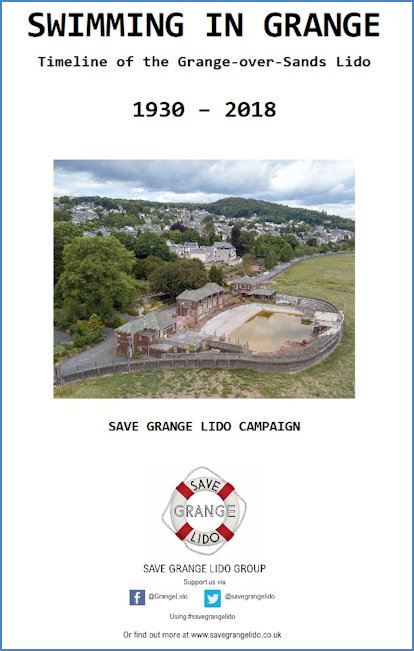Open Air Lidos
Home Page / Art Deco Home / Ocean Hotel / Midland Hotel / Everywhere Else / Derelict
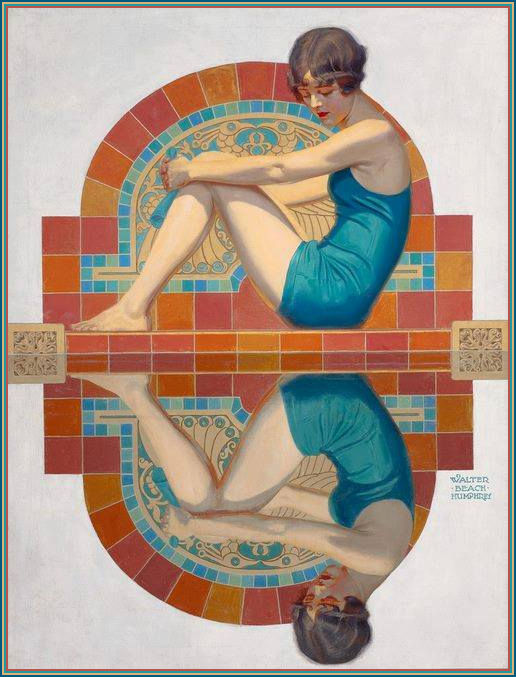
A wonderfully evocative image of an Art Deco swimmer created by Walter Beach Humphrey (1892-1966) for a 1929 cover of Collier's Magazine entitled 'Reflection' - image sourced from artnet.com
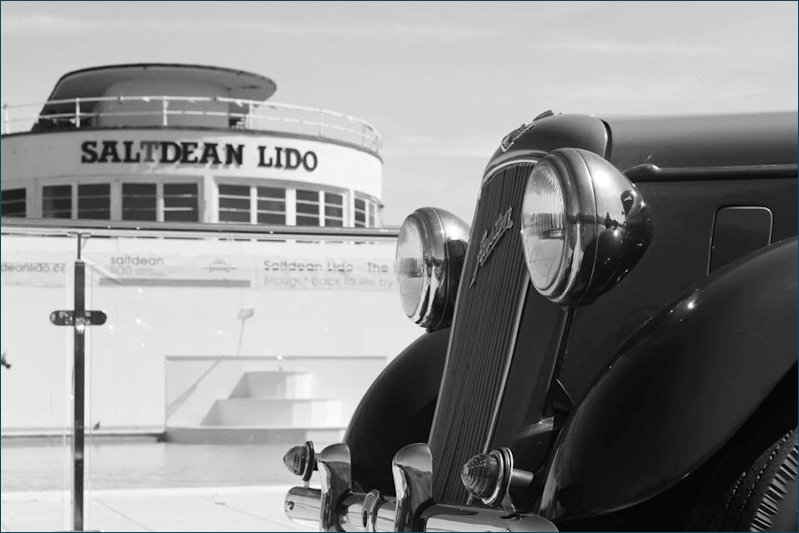
2018 - New Campaign

More fabulous artwork evoking the style of this wonderful Art Deco Open Air Swimming Pool returning to its original glory days! Image sourced from & © of the Saltdean Community Fb page. To learn more about the project visit Saltdean Lido and Spacehive
2017 - Saltdean Lido Re-Opens complete with visiting Mermaids
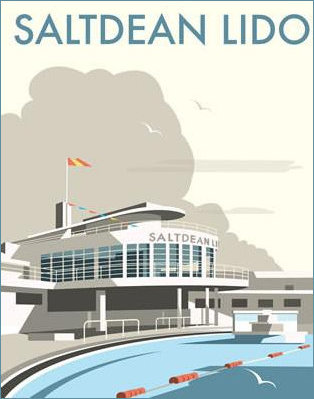
With enormous thanks to the Saltdean Zone, Saltdean Lido.co.uk, Saltdean Lido Community Interest Company, author and historian Douglas d'Enno, without whom the focus of this page would not have been possible.
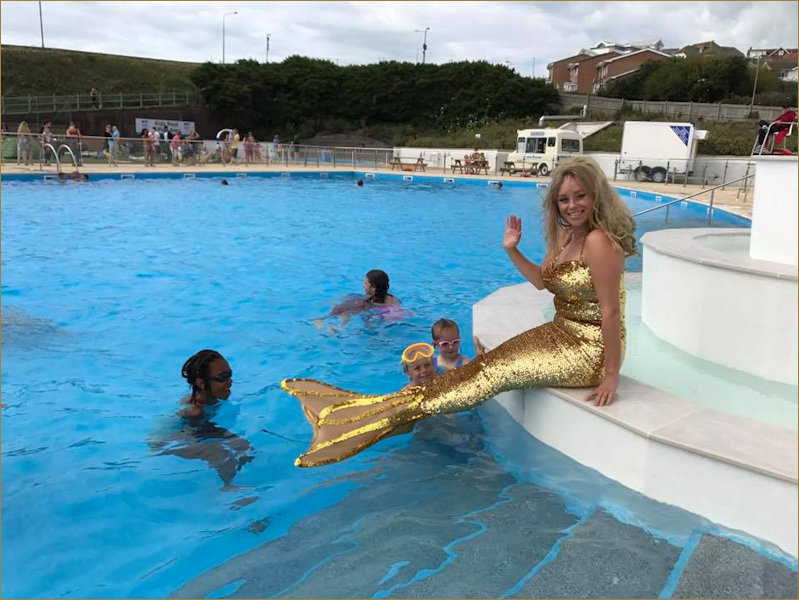
Special appearance by a golden mermaid in the newly opened Saltdean Lido
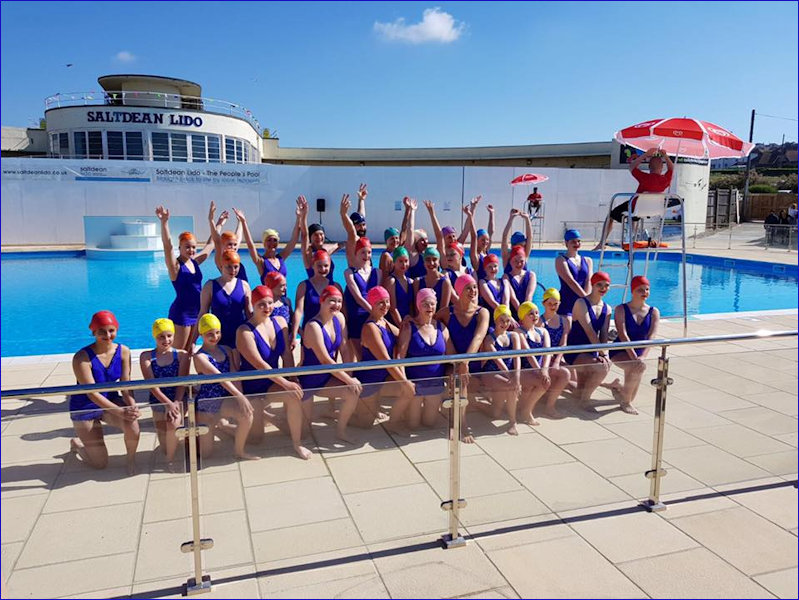
A clutch of mermaids - This is Jessie Jade's great group and choreography from Amphibious Fit. 'Really proud to be a part of it for the iconic reopening of the Saltdean Lido Community Interest Company.' - appearing in time for the re-opening of the pool.
No Pool should be without a fountain!
I'm very fond of fountains, even Carrington had an itty bitty one (see below) but the restorers have definitely worked miracles with this one - panoramic views first then close-ups :
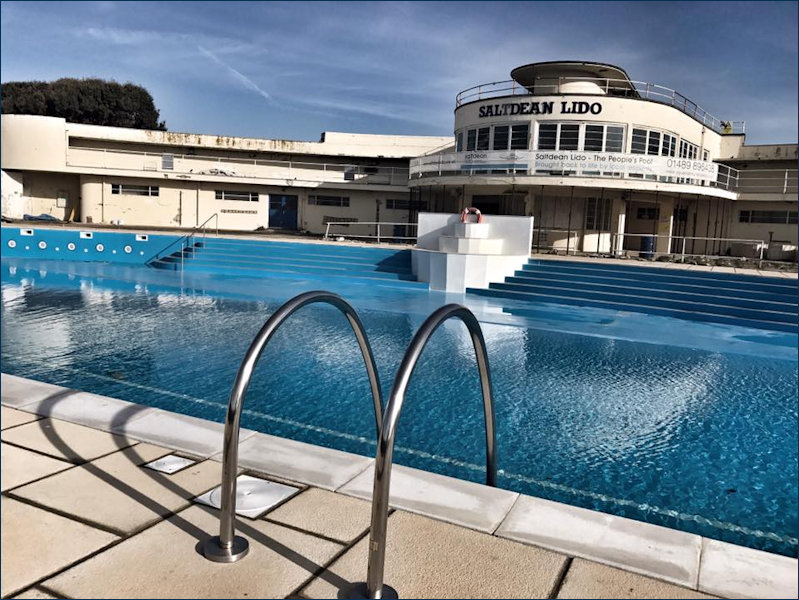
Everything is coming along a treat - doesn't that water just shimmer with vitality?
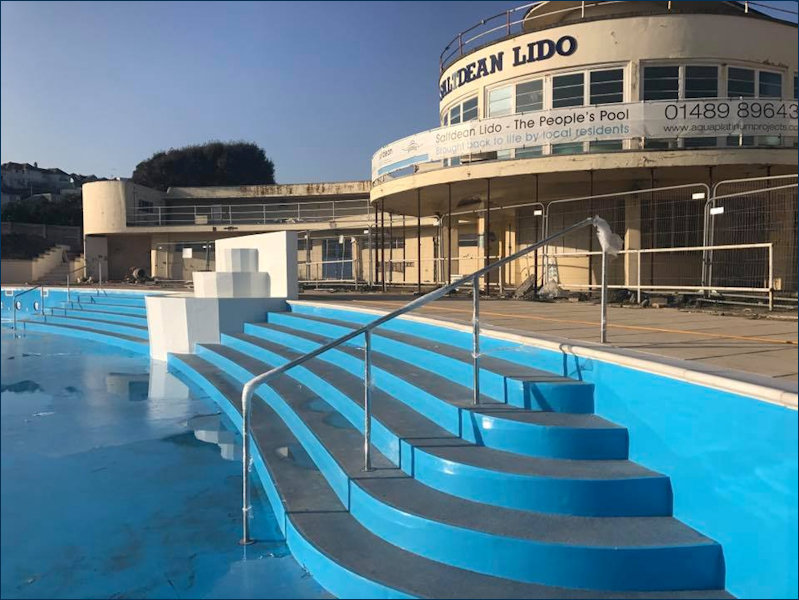
Nearly complete - the fountain is going to be a major player!
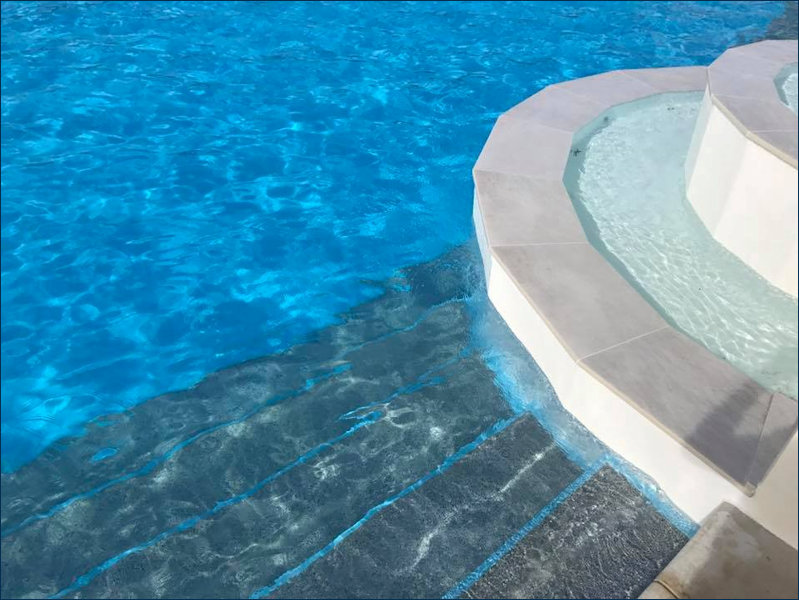
The fountain is still but it has many tricks up its sleeve .......
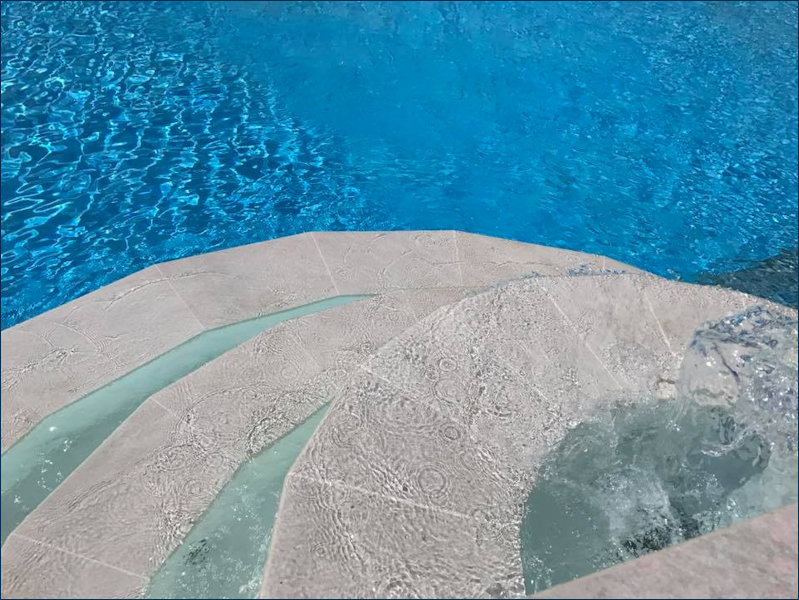
.... starting to froth a little ---
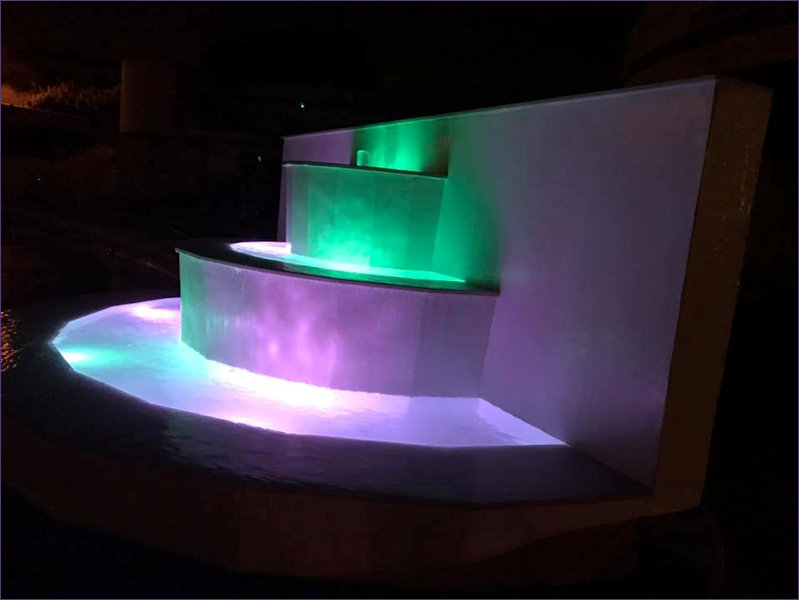
... party time! I couldn't resist this as these are my favourite colours - seen only in tandem at Wimbledon and now Saltdean - fabulous!
Using the original blueprints as a basis the restoration is as close to the original (with the addition of 21st century safeguards) as possible!
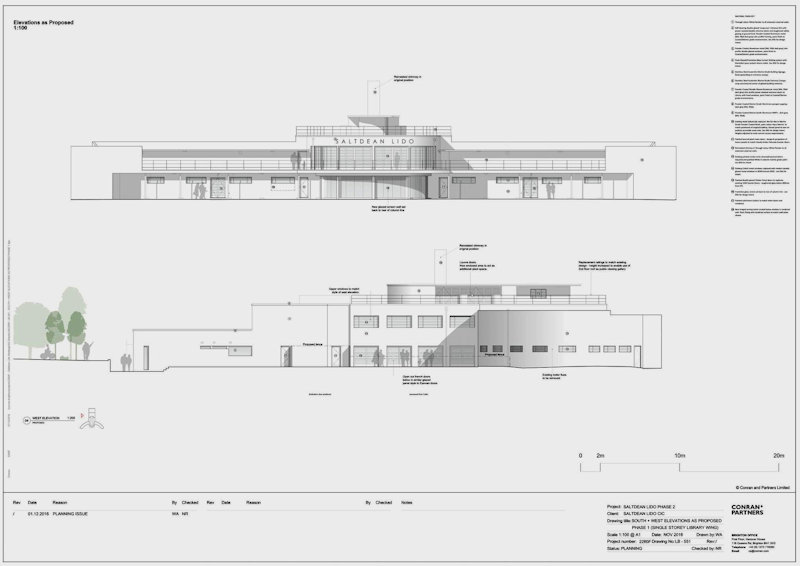
Southern and Western elevations detailing restored 1938 building with new café infill and library extension. © Contran & Partners
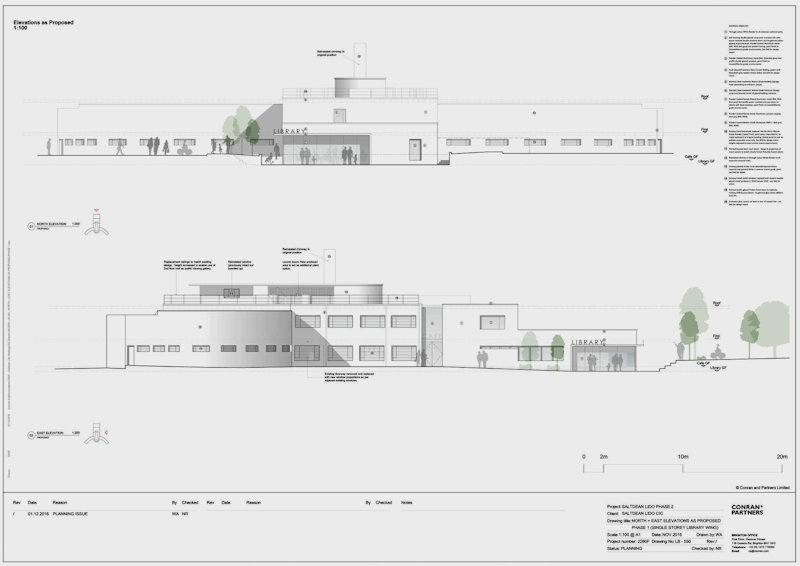
Northern and Eastern elevations detailing restored wings and new library entrance. © Contran & Partners
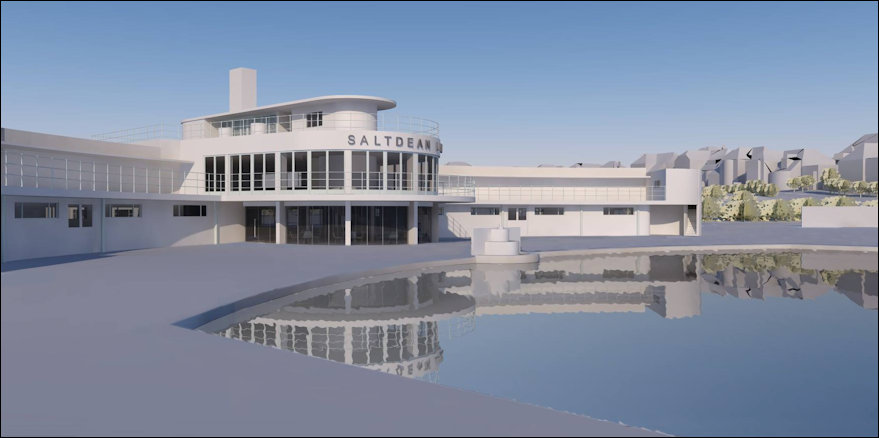
3D render depicting restored 1938 façade.
All images above from the Fb account of the Saltdean Lido Community Interest Company except where otherwise stated
1938-2017 > Saltdean Lido > The Ocean Hotel
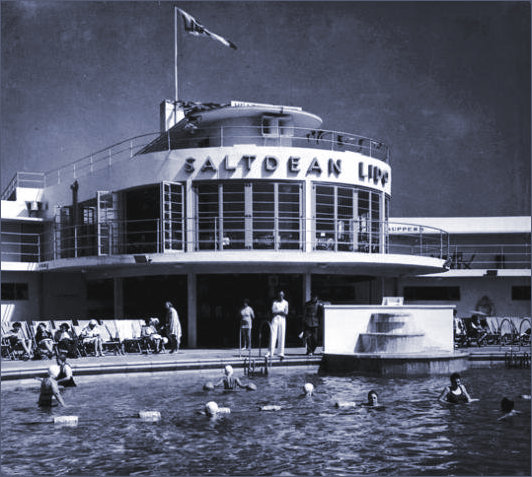
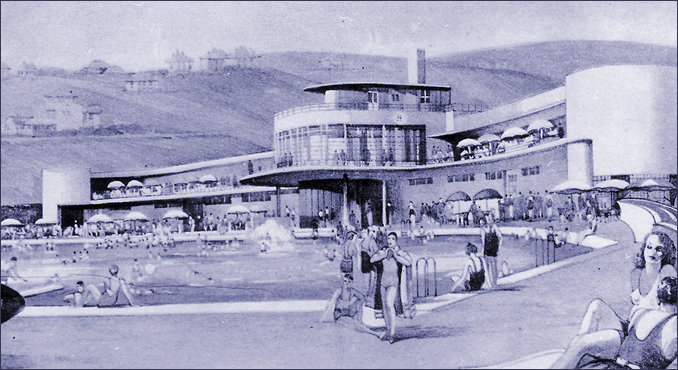
Much as I love the modern take on the truly iconic look of the Saltdean Lido - you can't beat an original artists impression illustration - this one sourced from Saltdeanlido.org
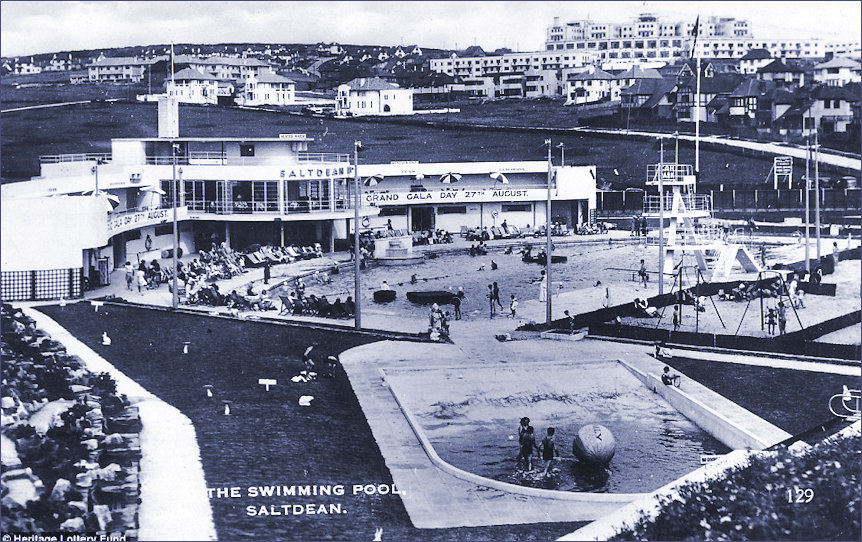
Opening Day in 1938 - "England’s only Grade II* listed lido (today), just four miles along the coast from Brighton, was designed as the centre piece of Saltdean’s new seaside resort and first opened in 1938 drawing in crowds from far and wide" - image courtesy of the Heritage Lottery Fund via the Daily Mail
Designed by RW Jones (who also designed the Ocean Hotel) this 1938 Open Air Lido was built of reinforced concrete, with sprayed cement finish painted white. During the Second World War the National Fire Service used the pool as a water tank and the grounds for training.
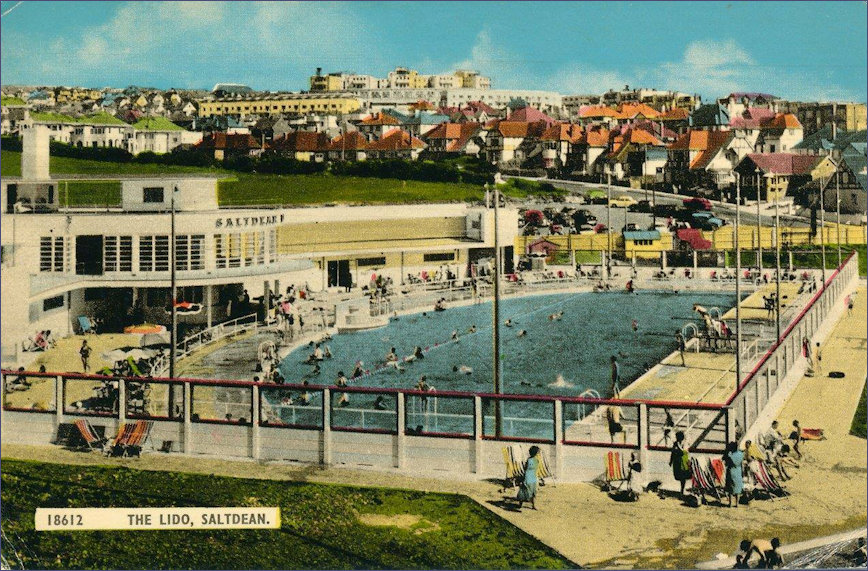
Standing proud above the Lido is the rear of the Ocean Hotel
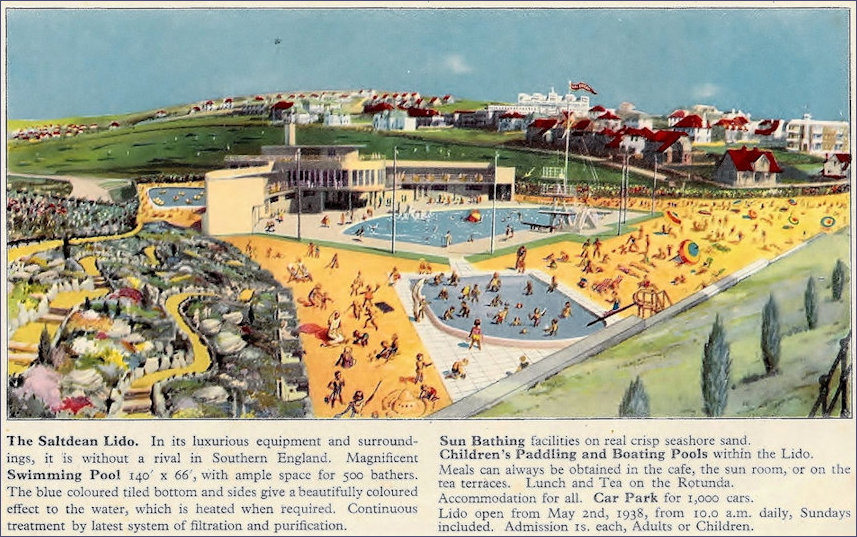
As promoted in 1937 (the Ocean Hotel can be seen on the hill in the background)
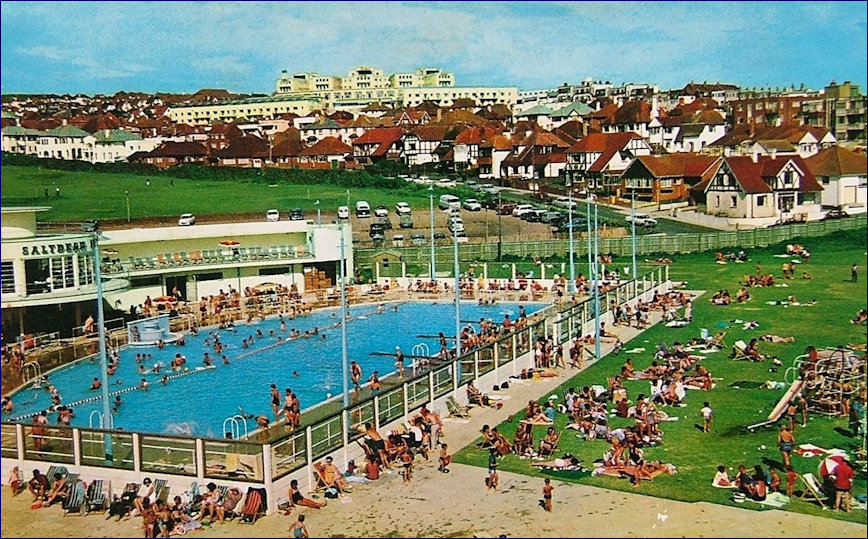
Still a popular venue as seen on this contemporary postcard from 1979

Then came the campaign to save Saltdean Lido which was becoming as derelict as the Midland Hotel!
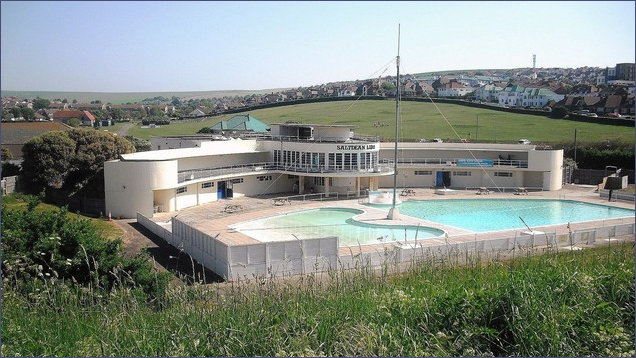
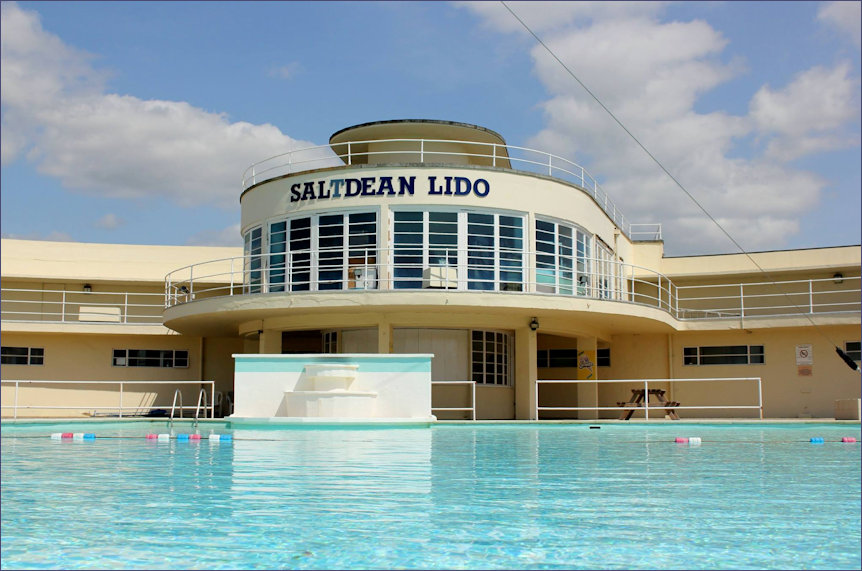
From here the deterioration becomes self-evident
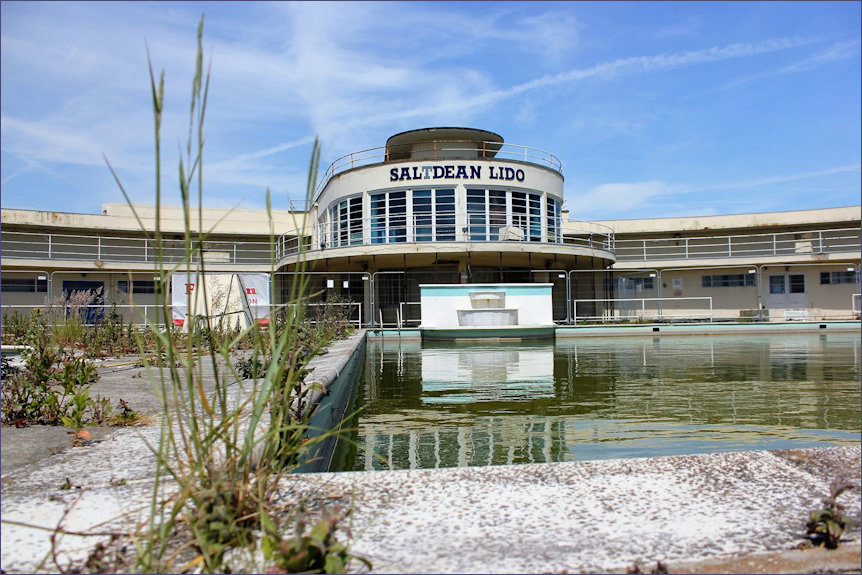
The start of the neglect .......
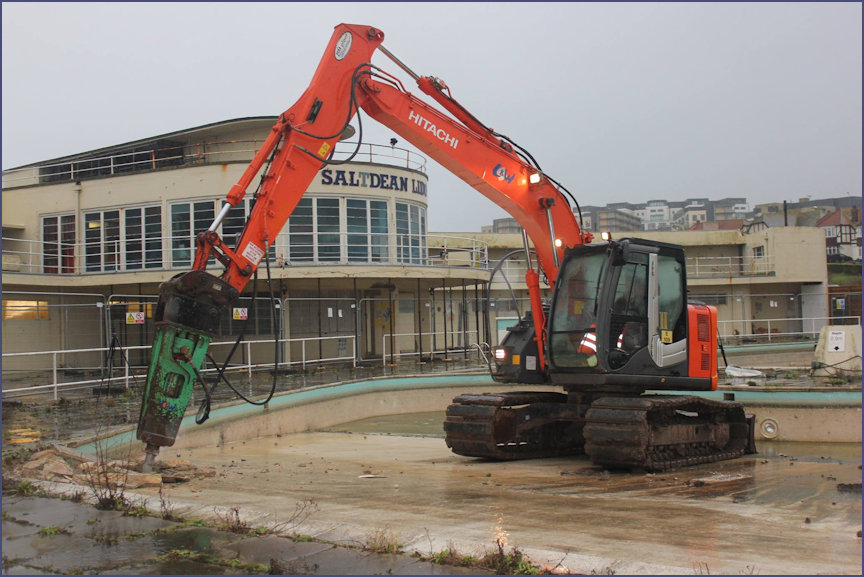
A sight which is all too familiar - the destruction of the original pool area in preparation for the renovation
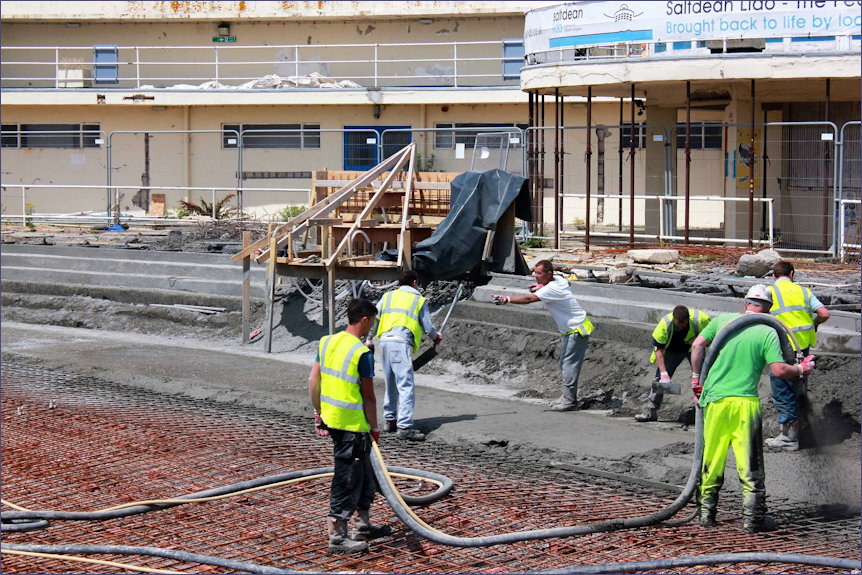
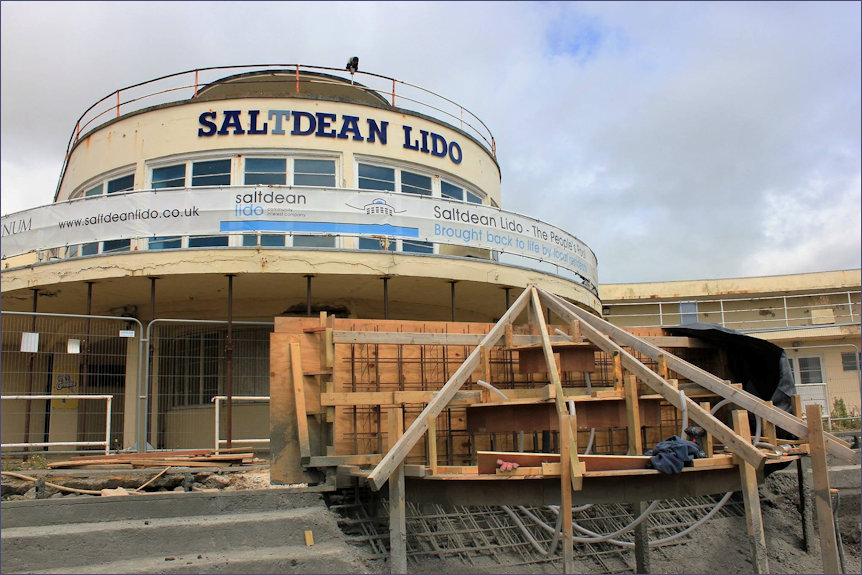
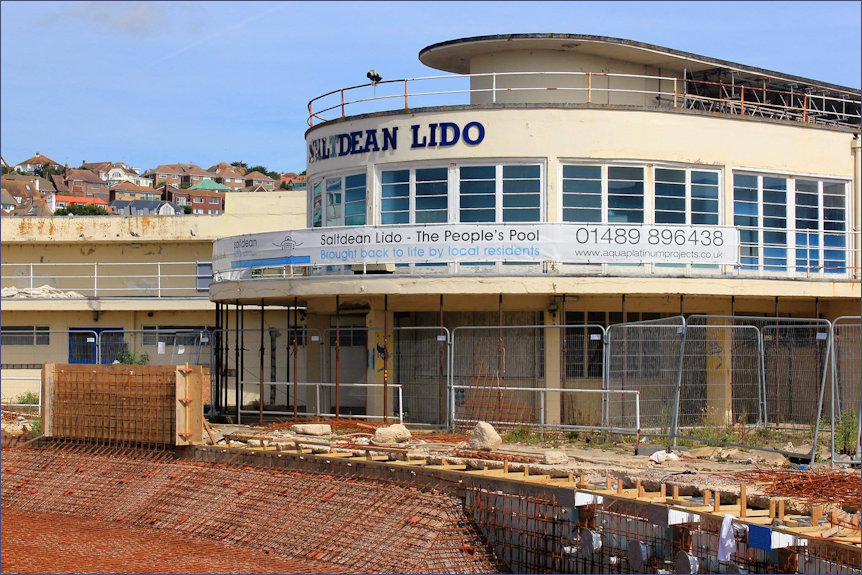
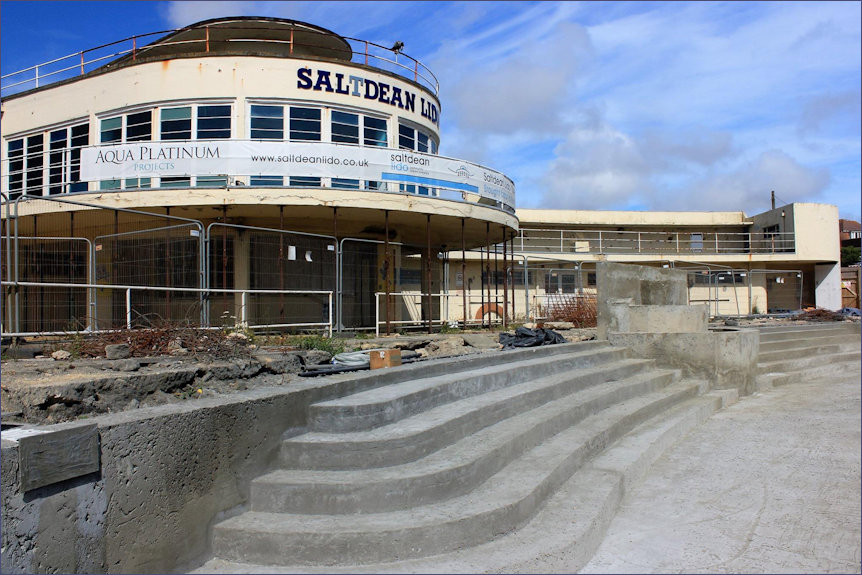
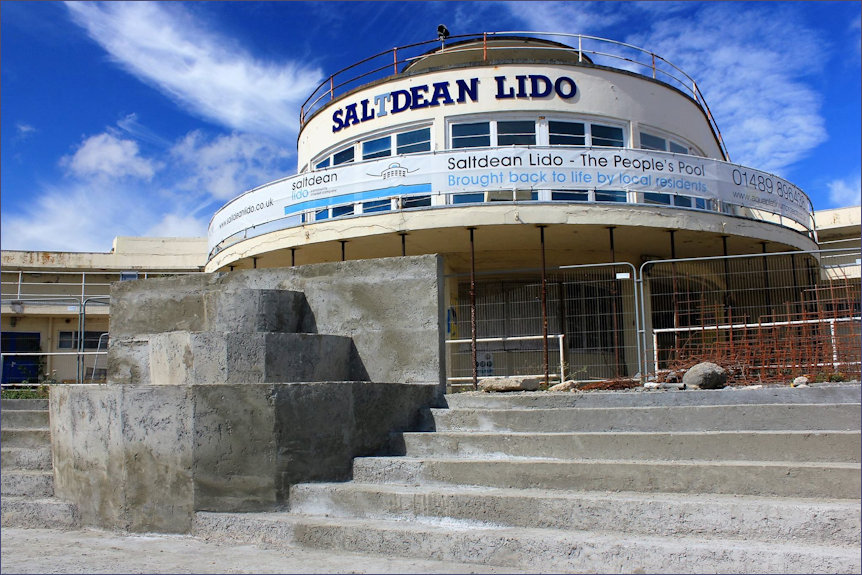
Working from the original architects plans the feature fountain begins to take shape
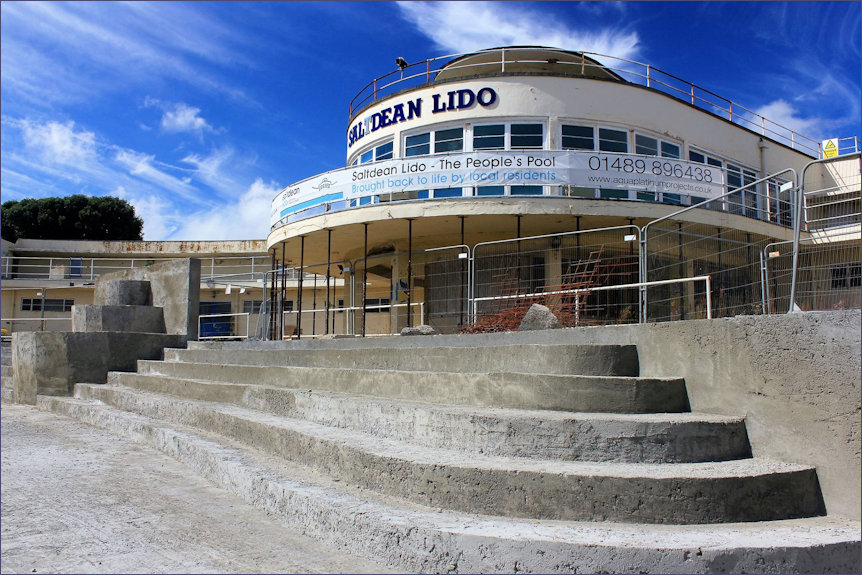
All images above from the Fb account of the Saltdean Lido Community Interest Company except where otherwise stated
History
One particularly pleasing example of the modern style is the Saltdean Lido, which happily still stands today. Saltdean is a suburb of Brighton which was developed extensively in the 'thirties and promoted to potential investors as "The Coming Resort". Saltdean itself has many fine buildings, built in the Hollywood Modern style - white walls and green roofs - popular in many seaside developments of the era. Saltdean's lido was designed by the architect, R W H Jones, who also designed the stylish Ocean Hotel in the same suburb.
The pool itself is situated near the coastline. It is relatively small, offering provision for only five hundred bathers. The main building behind is a two storey block, featuring a café with curved metal windows in its centre. Forming curved wings on either side of the café are the changing rooms on the ground floor and the sun terraces above these. The café resembles the bridge of an ocean liner. The effect is heightened by the presence of white curved metal railings on top of the café and in front of the terraces. Inspiration for the design appears to have been contemporary liner and aircraft design. No doubt, the nearby De La Warr Pavilion at Bexhill-on-Sea also had its influence. The pool itself has the popular features of a cascade in the centre and a diving board with curved railings styled to match the design of the main building. The design was well received by the contemporary architectural press. - Source : Seaside History | Read more here
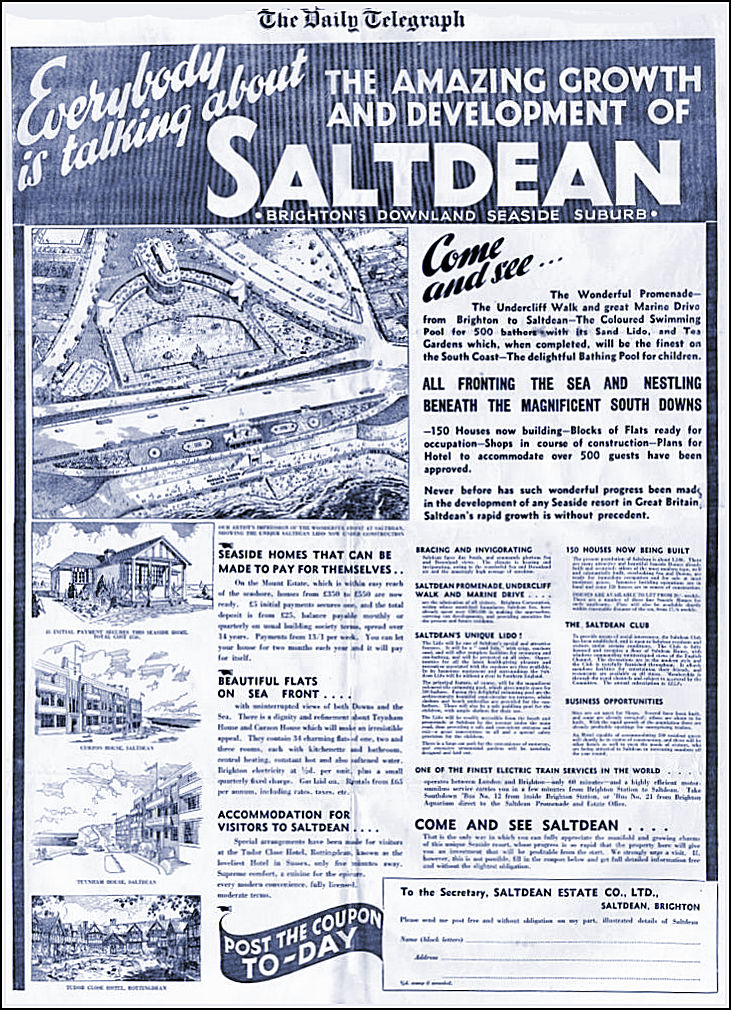
Images of this advertisement sourced from squarespace.com
1st July 1937 - 2012 - Weston-Super-Mare
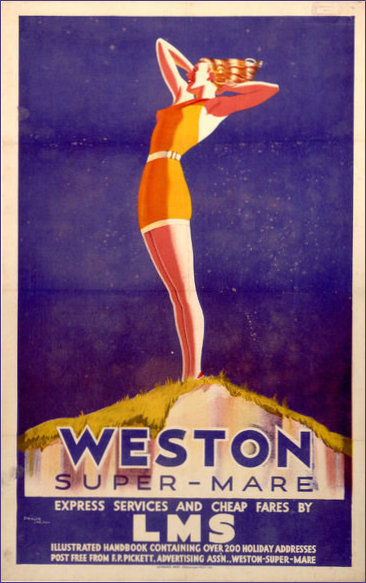
Weston-Super-Mare & LMS invested hugely in making a visual feast of the Lido and its unusual diving board - Image sourced from Media Storehouse
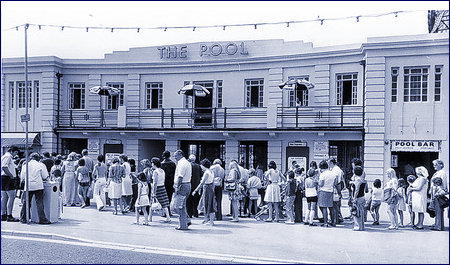
Modern day crowds still clamouring to enjoy the open air swimming circa 1970s - image sourced from scratch.mit.edu
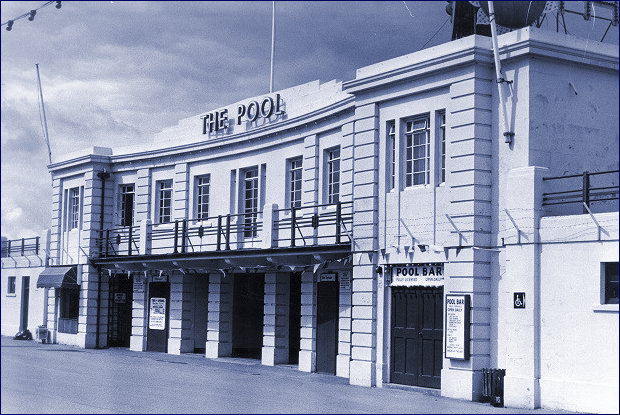
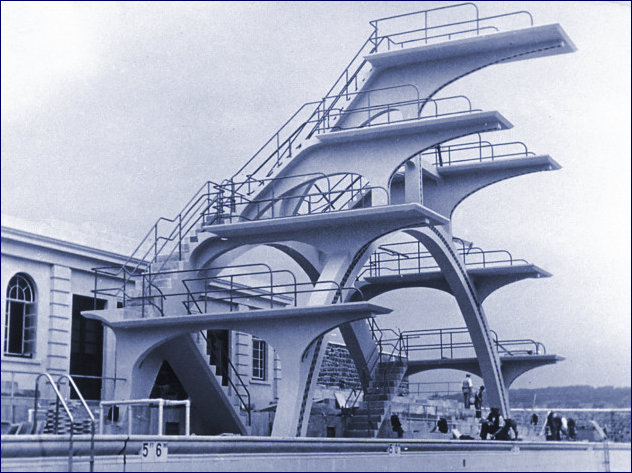
Images sourced from Weston Mercury and Pinterest
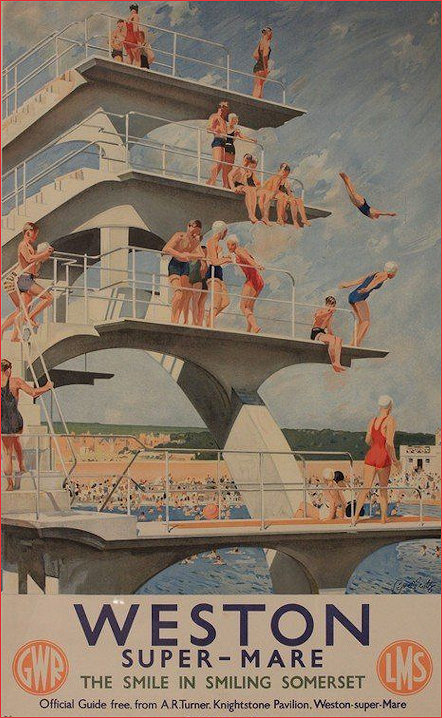
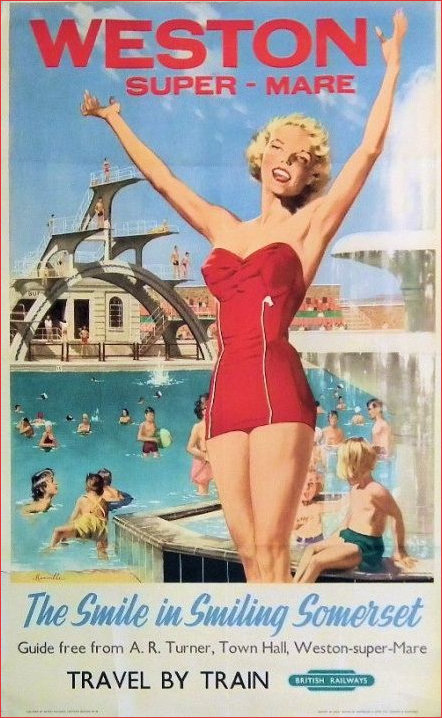
Two variations of artwork probably about 30 years apart both extolling the virtues of rail travel (GWR/LMS circa 1937) and (British Railways circa 1960s) to Weston Super Mare with the Diving Board clearly visible in both - with thanks to the Railways advertising department for coming up with the original images now redigitised.
Official Naming of the New Pool - 2nd July, 1937
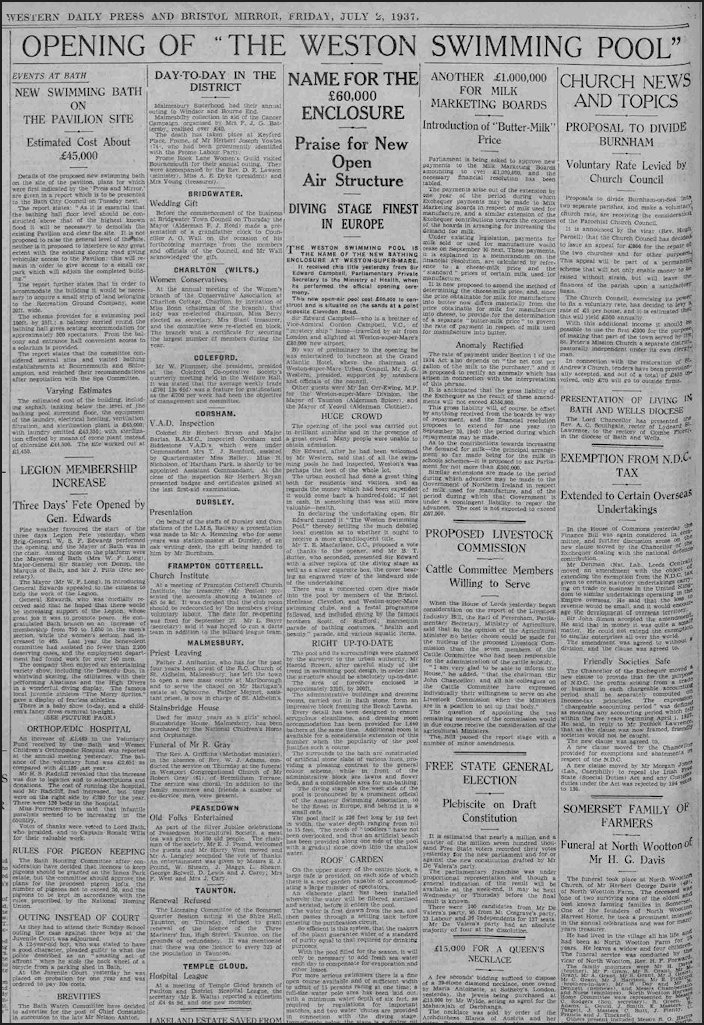
From the Western Daily Press - Friday 2nd July 1937 - courtesy of the British Newspaper Archive
The article reads :
OPENING OF "THE WESTON SWIMMING POOL"
- NAME FOR THE £60,000 ENCLOSURE
- Praise for New Open Air Structure
- DIVING STAGE FINEST IN EUROPE
- WESTON SWIMMING POOL IS THE NAME OF THE NEW BATHING ENCLOSURE AT WESTON-SUPER-MARE.
It received this title yesterday from Sir Edward Campbell, Parliamentary Private Secretary to the Ministry of Health, when he performed the official opening ceremony.
This now open-air pool cost £60,000 to construct and is situated on the sands at a point opposite Clevedon Road. Sir Edward Campbell—who is a brother of Vice-Admiral Gordon Campbell, V.C., of " mystery ship " fame — travelled by air from London and alighted at Weston-Super-Mare’s £80,000 new airport. By way of preliminary to the opening he was entertained to luncheon at the Grand Atlantic Hotel, where the chairman of Weston-Super-Mare Urban Council, Mr J. G. Western, presided, supported by members and officials of the council. Other guests were Mr lan Orr-Ewing, M.P. for the Weston-Super-Mare Division, the Mayor of Taunton (Alderman Spicer), and the Mayor of Yeovil (Alderman Clothier).
HUGE CROWD - The opening of the pool was carried out in brilliant sunshine and in the presence of great crowd. Many people were unable to obtain admission. Sir Edward, after he had been welcomed by Mr Western, said that of all the swimming pools he had inspected, Weston's was perhaps the best of the whole lot. The urban council had done a great thing both for residents and visitors, and as regards the money which had been expended it would come back a hundred-fold; if not in cash, in something that was still more valuable —health. In declaring the undertaking open, Sir Edward named it " The Weston Swimming Pool," thereby settling the much debated local question as to whether it ought to receive a more grandiloquent title. Mr T. E. Macfarlane, C.C., proposed a vote of thanks to the opener, and Mr B. T. Butter, who seconded, presented Sir Edward with a silver replica of the diving stage as well as a silver cigarette box, the cover bearing an engraved view of the landward side of the undertaking. There was a concerted open dive made into the pool by members of the Bristol, Henleaze, Clevedon and Weston-Super-Mare swimming clubs, and a festal programme followed, and included diving by the famous brothers Scott, of Stafford; mannequin parade of bathing costumes, " health and beauty " parade, and various aquatic items.
RIGHT UP-TO-DATE - The pool and its surroundings were planned by the surveyor to the urban authority, Mr Harold Brown, after careful study of the trend in swimming pool design, in order that the structure should be absolutely up-to-date. The area of foreshore enclosed is approximately 325 ft. by 300 ft. The administrative buildings and dressing rooms, carried out in Bath stone, form an impressive block fronting the Beach Lawns. Every detail has been designed to ensure scrupulous cleanliness, and dressing room accommodation has been provided for 1,440 bathers at the same time. Additional room is available for considerable extension of this number when the popularity of the pool justifies such course. The surrounds to the bath are constructed of artificial stone slabs of various hues, providing a pleasing contrast to the general colour scheme, while in front of the administrative block are lawns and flower beds, and a considerable area for sun-bathing. The diving stage on the west side of the pool is pronounced by a prominent official of the Amateur Swimming Association, to be the finest in Europe, and behind it is a small cafe. The pool itself is 220 feet long by 140 feet in width, the water depth ranging from nil to 15 feet. The needs of " toddlers " have not been overlooked, and thus an artificial beach has been provided along one side of the pool with a gradual slope down into the shallow water.
ROOF GARDEN - On the upper storey of the centre block, a large cafe is provided, on each side of which there is a roof garden capable of accommodating a large number of spectators. An elaborate plant has been installed whereby the water will be filtered, sterilised and aerated, before it enters the pool. The water is first drawn from the sea, and then passes through settling tank before entering the purification circuit. So efficient is this system, that the makers of the plant guarantee water of a standard of purity equal to that required for drinking purposes. With the pool filled for the season, it will only be necessary to add fresh sea water each day to compensate for evaporation and other losses. For more serious swimmers there is a fine open course available and of sufficient width to admit of 15 persons racing at one time; a full-size water polo area has been laid out. with a minimum water depth of six feet, as required by regulations for important matches, and two water 'chutes are provided in connection with the diving stage. Immediately below the stage is a diving pit with depth of 15 feet. Ample parking accommodation has been provided on the north and south sides of the undertaking.
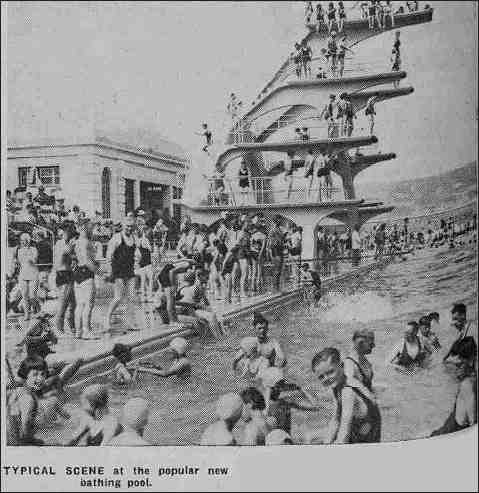
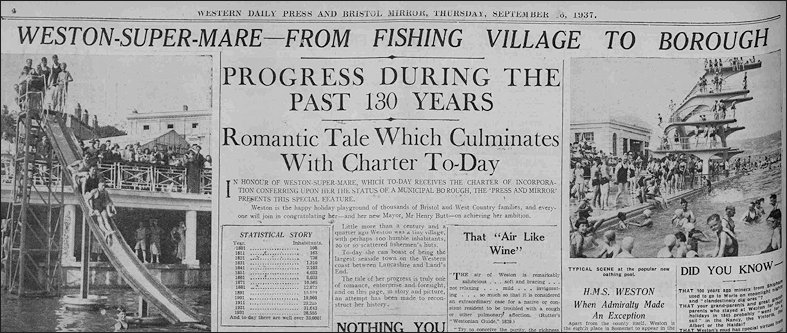
From the Western Daily Press and Bristol Mirror on Thursday, 16th September 1937 - the Weston Swimming pool referred to as the 'popular new bathing pool' - courtesy of the British Newspaper Archive
Consortium stages last minute bid to save resort’s Art Deco lido
When it opened in 1937, it was Europe’s largest outdoor swimming pool, a gleaming art deco monument to the glories of the English seaside holiday. Even the 30ft high diving platform built from a graceful arch of steel and concrete was a work of art.
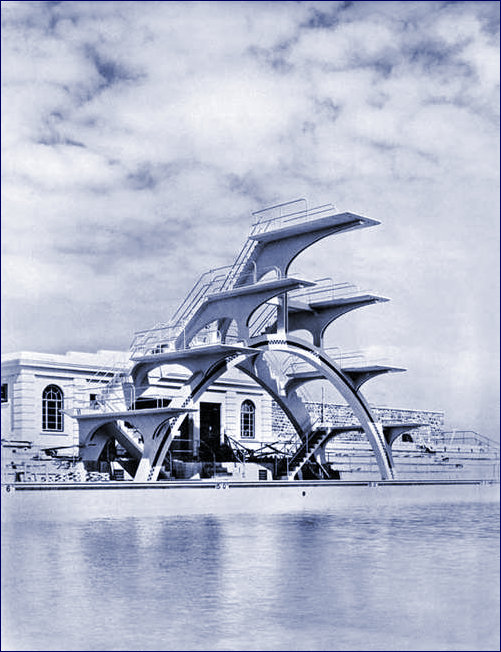
This really is a masterpiece of artwork for the 'humble' diving board and a sacrilege for having been demolished as early as 1982! - Image courtesy of Historic England ref: Photograph taken 1937 © Reproduced by permission of Historic England Archive ref: bb81/08505
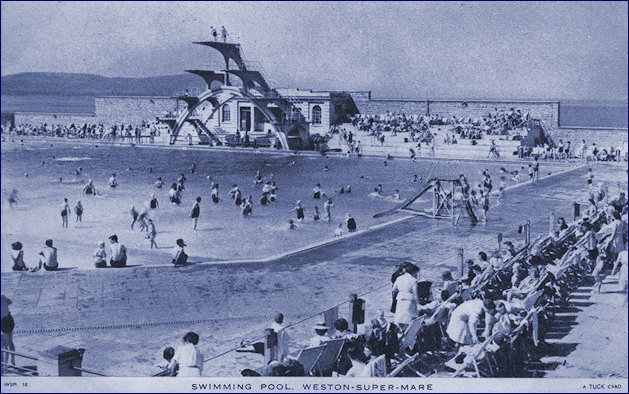
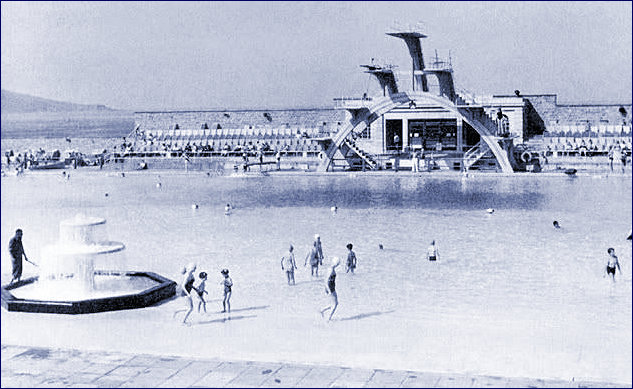
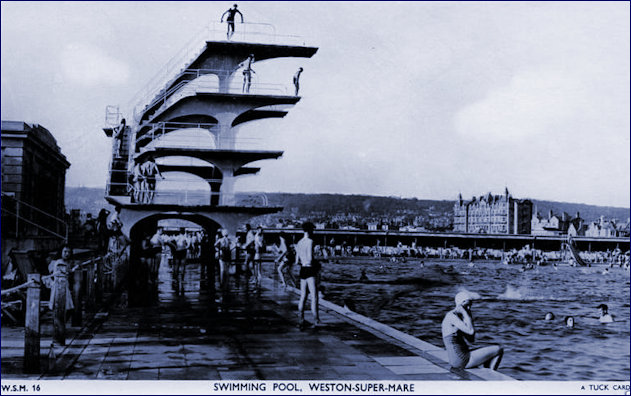
A couple of Tuck and one unknown postcards, most likely in contemporary time, showing the Diving Board to its full advantage from all angles - images sourced from Pinterest
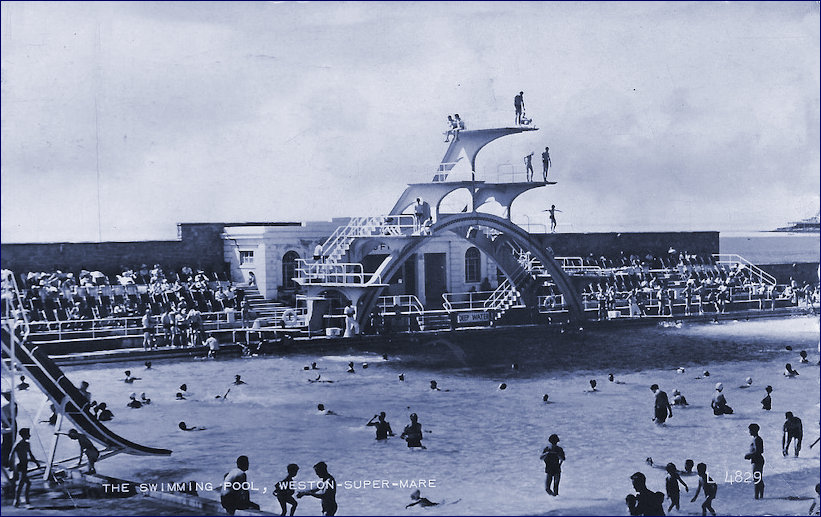
Nothing changes - swimmers are still enjoying the pool and unique diving board circa the 1960s - image sourced from Flickr
Now the pool in Weston-Super-Mare lies in ruins, its diving boards long gone and the grand facade stained and crumbling, but a last ditch attempt is being made to save it before the bulldozers move in some time in the next few weeks. Protesters picketed a meeting of the North Somerset Council in mid-December at which the decision was taken to go ahead with the demolition at a reported cost of £700,000. Their protests fell on deaf ears after councillors heard that no one had come up with a viable alternative. But a consortium of three local businessmen, including the man who saved the town’s Grand Pier after it burnt down three years ago, want to be given the chance to revive the lido, which was renamed the Tropicana in the 1980s. They have won the backing of the tourism minister John Penrose, who also happens to be Weston-Super-Mare’s MP.
Weston was once one of Britain’s most popular holiday resorts. Tens of thousands of workers would pour down from the industrial Midlands for their annual fortnight by the sea. But the seaside town was hard hit by competition from cheap package holidays and the invention of colour television, which led to the realisation that the sea is not always as cold, brown and murky as the Bristol Channel. The lido was originally called simply The Pool and was a success from the day it opened. Weston’s low tides mean that a dip in the sea can mean a long trek across potentially treacherous mudflats. Not only was the pool water cleaner and clearer than that in the Bristol Channel. Fifteen feet deep beneath the diving platforms, the 950 sq metre pool was large enough to accommodate international swimming galas as well as recreational swimmers. Its white walls provided shelter for sunbeds and cafes and thousands would pack in every day the sun shone. The Pool enjoyed three glorious summers before the Second World War put everyone’s holiday on hold.
After the war it reopened with a bang, hosting one of the first big beauty pageants, the Modern Venus contest. In 1945 more than 2,000 spectators watched a teenager from Swindon called Diana Fluck take third place. She later became better known as the actress Diana Dors. The contest was a highlight of the summer for thousands of holidaymakers until the last Modern Venus was chosen in 1973.
By then the English seaside holiday was also in decline. In 1983 the tired looking pool was given an £800,000 facelift, the Grade II listed diving platform was knocked down, a wave machine installed and it was renamed the Tropicana. The result was a fresh but temporary lease of life. By 2000 the council had had to take over running of the pool and the maintenance costs had become so prohibitive compared to the receipts that it was closed pending an expected revamp by a new developer. Successive schemes were mooted but every one of them collapsed in the face of the chilly reality of trying to make a profitable business out of an unheated swimming pool in an unfashionable resort. There was talk of a cinema and restaurant complex, a hotel and a water park but all evaporated with the recession.
Mr Michael said: “As a teenager I spent many happy days there. For a resort the size of Weston not to have a pool for visitors on the seafront is just not right. “Until they actually demolish it we will keep applying pressure. We want to retain what’s there rather than pull it down and start again. We are all long time developers and we’ve been round the site and the structure itself is sound.” Mr Michael, 52, wants the council to give the site to a trust which could reopen the pool and reinvest any profits rather than pouring millions in a one-off redevelopment. Ultimately he hopes that heating the pool, possible with solar panels, and putting a retractable roof over it would turn it once again into a world class attraction. Mr Pentorse, who is also tourism minister, has urged the council to give them a chance to revive it. In a local newspaper column he wrote: “For years, the Trop was one of our local icons, alongside the Grand Pier and the Prom. Sadly, nowadays it’s dragging the rest of the seafront down and we can’t just let it sit there rotting for another 10 years while we wait for a white knight to take it on. “If local businessmen like Kerry Michael and Derek Mead think they make it pay, we should bend over backwards to give them the chance. If anyone can do it, they can.” North Somerset Council has held out a small glimmer of hope for The Pool. It says it will consider any rescue package before demolition starts in the new year. Source : The Times (3rd January 2012)
From the Weston Mercury, dated 4th December 2011, a chronology of the site of the former Open Air Swimming Pool (Tropicana) by Tom Wright
An icon or an eyesore?
Nothing has divided opinion in Weston more than the Tropicana in recent years, and emotions are running high once again following this week’s recommendation for demolition.
Here, we look back at the Tropicana’s highs and lows before the site is consigned to the history books.
July 1 1937 – the pool opened its doors to the public following a £60,000 project, giving Weston an outdoor swimming pool and iconic diving boards.
1947 – Hollywood film stars Laurel and Hardy were guest judges at the town’s Modern Venus beauty competition.
1982 – the attraction closes to the public for renovation after Woodspring District Council successfully applied for permission to demolish the then-listed diving boards. May 1983 – following a £1million redevelopment the Tropicana Pleasure Beach reopened to the public. The diving boards were replaced by a wave machine, fruit-shaped water chutes and a water heater. On its first day 7,500 visitors turned up, meaning many had to queue until 6pm.
1992 – North Somerset Council pulls out of sole running it and private owners take on responsibility for it.
June 1997 – the Tropicana celebrated its 60th birthday with a spectacular party and fireworks display opened by comedian Eddie Large. Weston celebrities Jill Dando and Lord Archer sent birthday cards.
1999 – signs of strain emerge as it only opened for seven weeks during the summer and made a £16,000 loss.
2000 – North Somerset Council spent £70,000 ensuring it reached health and safety standards. But after just six weeks it closed again, recording a loss of £38,000 for the year. It would never open again.
2003 – a £23million investment bid by developers Mace is accepted by the council. An indoor pool, a cinema, health club, cafés, bars and restaurants are all proposed.
November 2004 – Mace pulls out and the council appeals for new interested parties to come forward.
April 2005 – North Somerset Council expresses wishes for a pool and shortlists several would-be developers. Weston businessman Richard Nightingale fails to make shortlist.
July 2005 – Henry Boot’s £25million bid gets the green light from the council. The company expects to open its ‘Lifestation’ complex in October 2007.
February 2006 – the project is delayed and it is announced that it will not open until autumn 2009 at the earliest.
February 2008 – following nearly 20,000 objections over issues such as parking and size, a scaled back proposal involving a pool, hotel and bowling alley is resubmitted.
October 2008 – North Somerset Council backs plans despite spiralling costs of an estimated £48million and opposition from English Heritage. Expected to open in 2011.
November 2009 – Henry Boot pulls out of the Tropicana and the council admits there are no plans left on the table.
January 2010 – Richard Nightingale unveils his £19million redevelopment blueprint, designed after ‘listening intently’ to the public.
March 2011 – a ‘devastated’ Richard Nightingale pulls out after council rejects his plans, blaming ‘European legislation’.
July 2011- Councillor Elfan Ap Rees tells the Mercury he thinks a pool is ‘undeliverable’.
October 2011 – the Tropicana is marketed by the council once again. A budget cap of £3.5million is fixed to it.
November 28 – behind closed doors, the council’s working party recommends demolition, costing an estimated £800,000. The matter will go before the executive committee on December 13.
Taking up the chronology from 2012 - scratch.mit.edu
In 2012 the shop and cafe closed and boarded up, by this time all evidence except the pool and fountain remain from the dumping tip.
In 2015 a new cafe called The Bay opened and Banksy's Dismaland took place for 6 weeks.
2016 - Earlier this year a new tourist information centre opened and it looks like a bright future for the Tropicana.
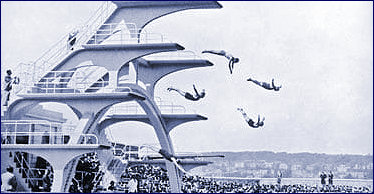
What an evocative and joyous picture of open air divers in full flight "Spirit of the age ... Weston-Super-Mare lido in 1937. Photograph: St Andrews University Library" - image sourced from St. Andrews Library via the Guardian
Steve Rose writes movingly in 2006 - "It has been argued that human beings love the water because we evolved from a species of aquatic ape, but if you look at the state of Britain's swimming pools, you wonder if we're now heading in the opposite direction. Having spent the past few centuries developing ever more sophisticated monuments to aquatic recreation, swimming pool architecture seems to be in a state of regression.
Swimming architecture in Britain reached its evolutionary peak in the 1930s and 40s. This was the golden age of the lido, an era to which older swimmers look back with nostalgia and younger ones with envy. The word itself (derived from the bathing resort just off Venice) conjures images of something more exotic than a utilitarian swimming pool ("machines for swimming in", as Iris Murdoch, who preferred rivers, described them). The prospect of being able to swim outdoors, lie in the sun and generally reconnect with our inner aquatic ape was appealing enough to interwar Britons, but lidos were also places to commune. They were an environment outside the ordinary rules of society, where physiques could be safely displayed and appraised, and where the mixing of the gene pool was a distinct possibility." Read more
Updated Tropicana Timeline
An excellent new Tropicana timeline web-page (how quickly information changes) is now available with excellent pictures at tropicanaweston.co.uk - but don't forget the Derelict years!

How could you possible want to lose the history of a boast like this? - Image sourced from : Pinterest
1937 - 1988 - Carrington Lido in My Back Yard
This is another of my regular places of entertainment whilst I was growing up on Church Drive, Carrington, Nottingham. The front of the house looked out onto a cemetery (hence, presumably my lack of shock/horror where cemeteries were concerned). Directly beyond the cemetery we could see, from the first floor front room (which used to be a joint bedroom for my sister and I and then became the upstairs 'salon') bay window the highest level of the diving board at the Lido. To get to the Lido I had to turn right out of the front door, walk the length of our half of Church Drive, which took me passed the entrance to St. John's Church, turn left at the end and walk a few yards passed the church and the bus-stop and then on my left I saw this :
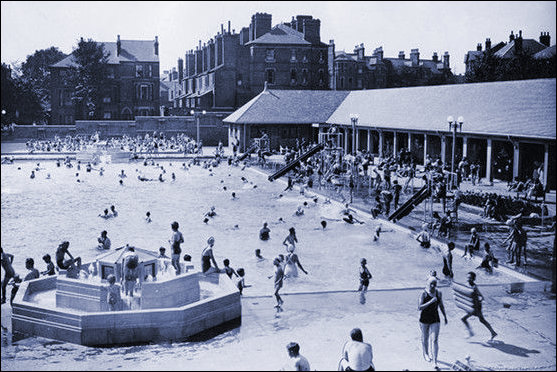
As soon as I could get passed the gate and the revolving entrance this is the sight that would greet me! Always loved that Fountain although I perched at the far end with the 'twin' facing one. Image courtesy of Nottingham.com (link broken)
From The Nottingham Evening Post dated 29th June 1937 just prior to the opening of the Lido
Or more to the point it's likely it would have looked more like this:
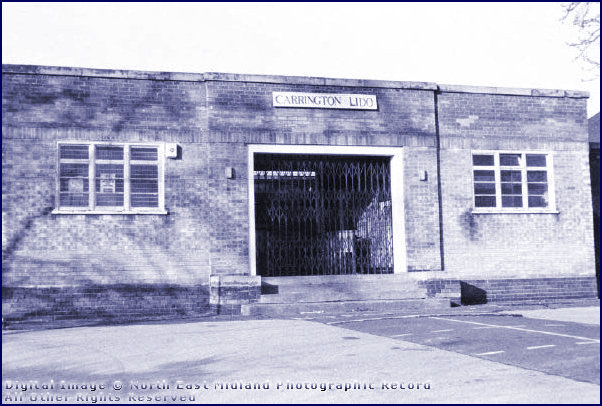
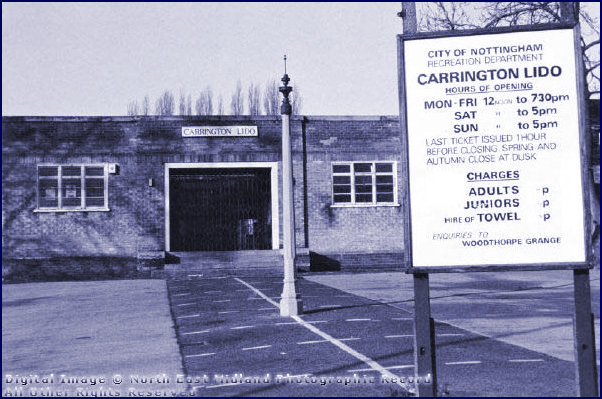
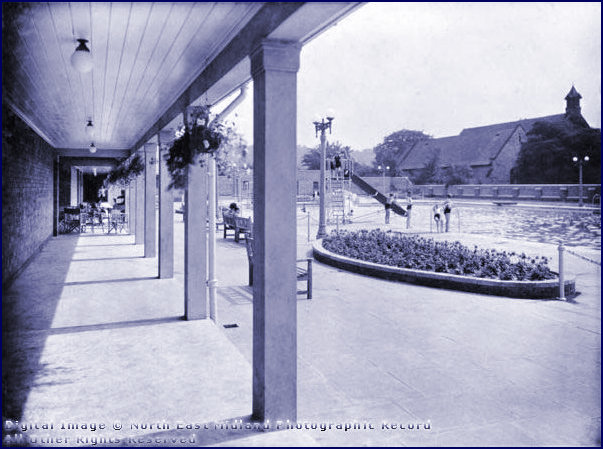
I remember this view well - it was always nice to see the flower arrangements and the Church visible in the distance behind the separating wall. This walkway ran the length of the building which housed the Canteen and Changing Room areas
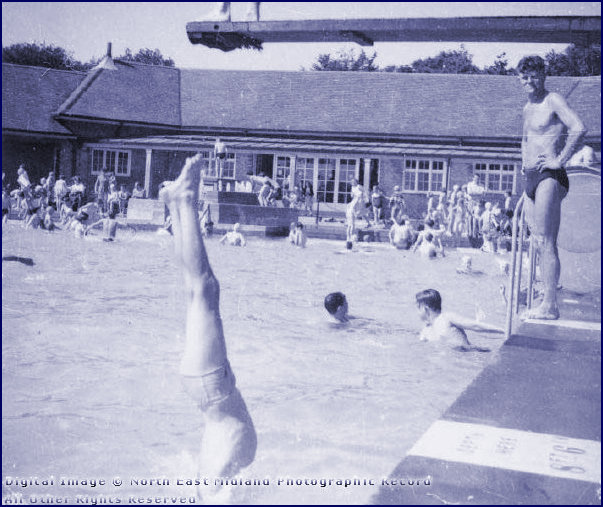
Opposite the Changing Rooms and Canteen area, visible in the background, were the diving platforms for the daredevils. There was one further platform above the one visible in this picture, which is the one we could see from the house. There was a lower diving board to the left of the main structure for more timid divers/jumpers. Images © of Picture the Past
There was a lovely little fountain feature which I loved at the shallow end but am unable to source an image and a free-standing fountain directly at the opposite end of the pool - I loved this place (sigh!)
History
There isn't much still available about the history of the Lido even though it was such a big part of my life when I was growing up and when I was still 'whole'. But what there is I can reproduce here :
From 'The History of Carrington' by Terry Fry - Carrington Lido opened on July 29th 1937, the same day as the one at Bulwell. It cost £20,000 and was built on the site of the old horse-drawn tram stables. Obviously, an open-air pool was very popular in hot weather, but in a poor summer takings were low and for the rest of the year it stood idle. It closed for the last time in 1988. It was intended to build a library next to the lido but the Public Libraries Committee said, in 1934, that it did not require the land for that purpose.'
There is an interesting article in the Nottingham Evening Post about the funding of the Open Air Swimming Pools in Nottingham dated 2nd April, 1936 : '£39,000 for Nottingham Swimming Pools - Veritable Lidos - Loan Approval by Health Ministry - Council Scheme - Carrington and Bulwell sites.
In 1939 pre-WWII
From the Nottingham Evening Post April 19th 1940 - no details given as to why the Auxiliary Fire Service had to spring clean the pool 'in record time'
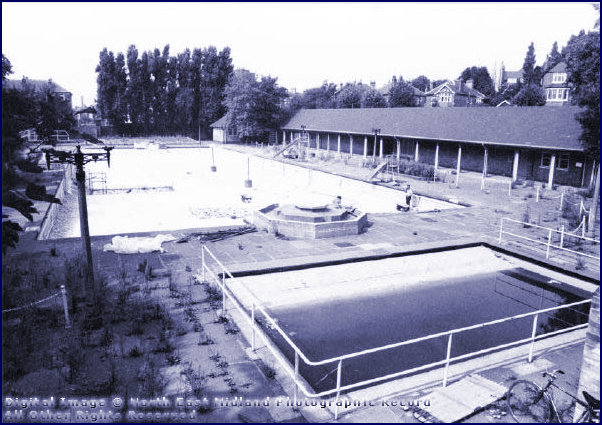
Inevitably, of course as this picture shows, the neglected lido became derelict prior to demolition - Image © of Picture the Past
1936 - 1988 Portobello Bathing Pool, Edinburgh
So little historical, architectural and general information is recorded that this Bathing Pool will be covered with 'snippets' and 'reminiscences' with acknowledged sources. Luckily Valentines postcards provide valuable historical timelines and are still available.
From (l to r) the Berwickshire News & General Advertiser dated Tuesday, 26th May and the Southern Reporter in August 1936 - Gala Fireworks display - images sourced from the BNA
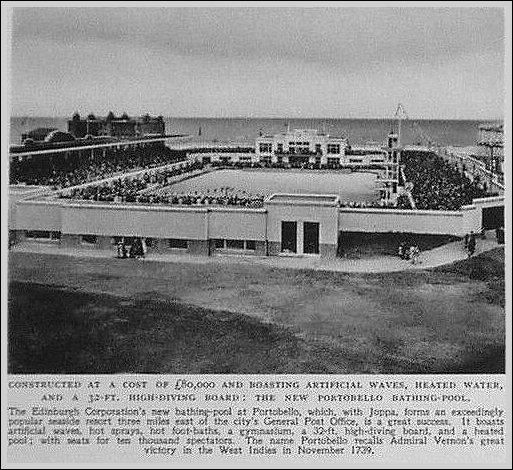
"Constructed at a cost of £80,000 and boasting artificial waves, heated water and a 32ft high Diving Board: The New Portobello Bathing Pool"
"The Edinburgh Corporation's new bathing-pool at Portobello, which with Jappa, forms and exceedingly popular seaside resort three miles east of the city's General Post Office, is a great success. It boasts artificial waves, hot sprays, hot foot-baths, a gymnasium, a 32ft high-diving board, and a heated pool; with seats for ten thousand spectators. The name Portobello recalls Admiral Vernon's great victory in the West Indies in November 1739."
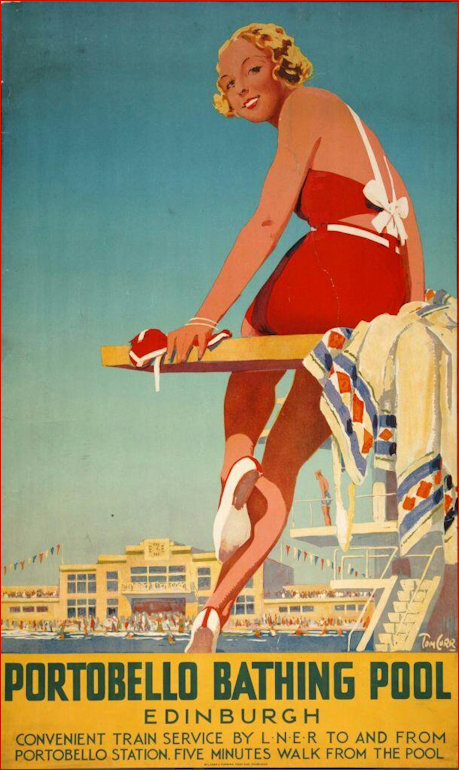
Artwork by Tom Curr
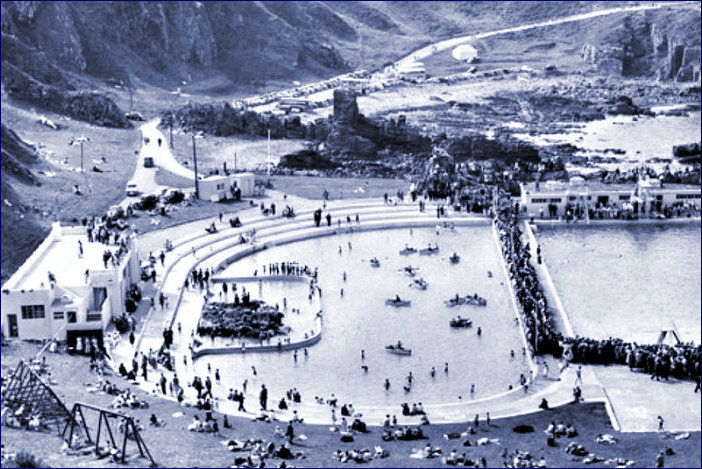
The Scotsman (erroneously) features this as the Portobello in their article 'Long Days of summer swimming that simply drifted away' - thanks to Anna Reid Jones for spotting the error and letting me know and discovering that this is in fact a picture of Tarlair Macduff
From the article : "The Art Deco marvel of Portobello opened in 1936 and was the first in Scotland to feature a wave machine. It was hugely popular, with the pool operating a ‘one in, one out’ policy during the summers of the 1970s. Heat to the pool was supplied by the nearby Portobello Power Station. The rise of foreign holidays dented its popularity with the closure of the power plant in 1978 a major blow to its survival. The 1979 season turned out to be the last and demolition was finally approved in 1988. A leisure centre and 5-a-side football pitch now stands on the site. At Helensburgh outdoor pool, it was often said the water was warmer once it had rained. The pool was gifted to the town by Provost Andrew Buchanan after he survived an infamous outbreak of food poisoning which killed several of his friends." Read more
Lost Edinburgh: Portobello Bathing Pool
A busy day at Portobello Bathing Pool during its inaugural year - 1936
This gigantic Art Deco outdoor pool was opened in 1936 and operated for more than 4 decades. The place would be packed in good weather with queues the length of Westbank Street (formerly Rosebank Lane for some unknown reason) commonplace. Edinburgh's poor climate and the advent of cheap package holidays abroad took their toll on seaside resorts such as Portobello and the 1979 season would be the bathing pool's last. It was demolished in 1988. The Portobello Pitz 5-a-side football pitches are now located on the site. It's said that waste water from Portobello Power Station was piped underneath the pool to heat its icy contents. Once the power station closed in 1978, the pool's days were numbered - particularly since the city now boasted the suitably large (and indoor) Commonwealth Pool. Source : Lost Edinburgh (Fb)
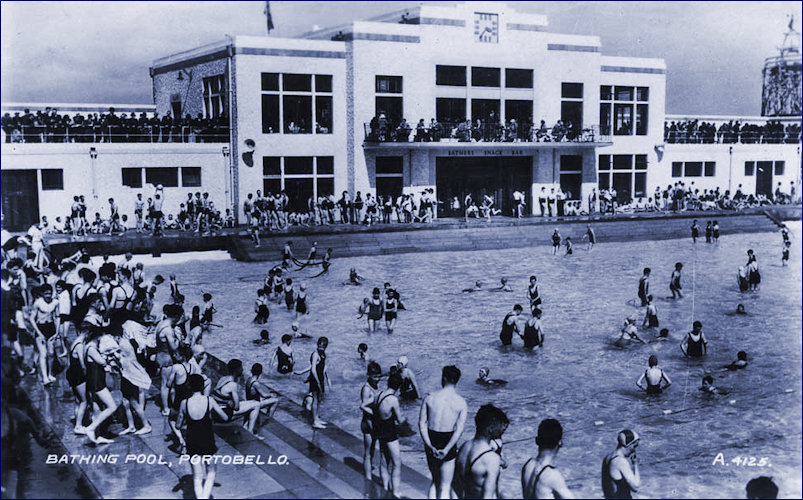
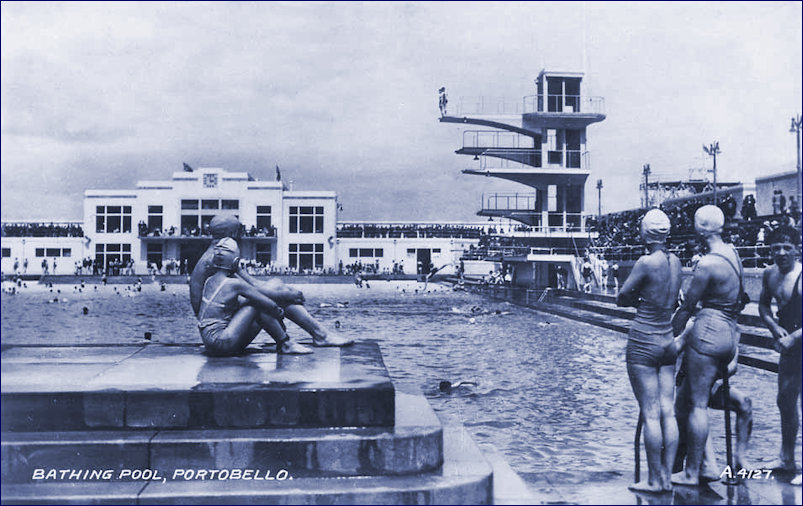
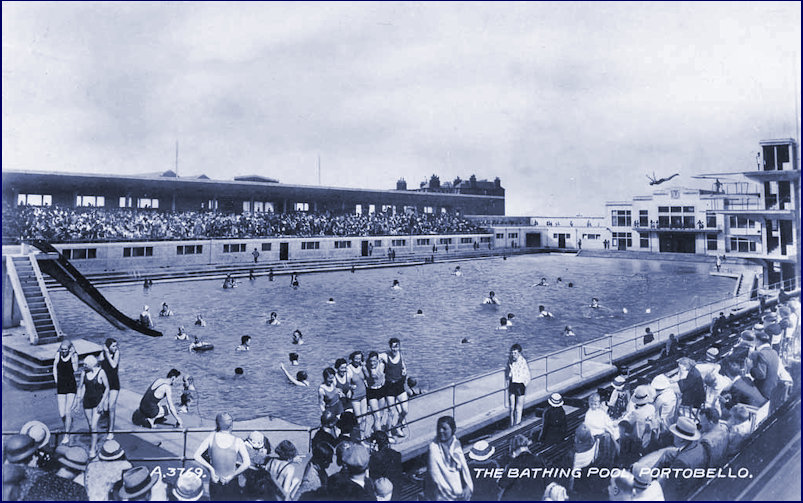
All three Valentines postcards have been identified as being taken in 1936 in the weeks after the opening of 'Edinburgh Corporations New Bathing Pool'
From the top the sunbathing terraces and balconies for use by swimmers (up to 1300) and non-swimmers (up to 600) alike (at any one time) showing off the Streamline Moderne features of the entrance, the diving board and its clever artistic and practical design blending into the overall look and a general view of all the amenities and diver caught mid-air executing a beautiful and graceful dive. Images sourced from an excellent website edinphoto.org
PORTOBELLO Bathing Pool, famous for its distinctive Art Deco design, lofty diving boards, artificial waves and chilly waters, enjoyed a status as one of the city's most alluring attractions for over 40 years. Built in 1936, the open-air Art Deco marvel promised to be a big hit. It was the first in Scotland to feature an artificial wave making machine and the largest pool in Edinburgh up until the creation of the Commonwealth Pool in 1970. During open season, the pool attracted large numbers of visitors and swimming enthusiasts from all over the country. The queue to gain entrance would often stretch the full length of Westbank Street. A one in one out policy was eventually adopted on the most sunniest of days in the 1970s, in accordance with the pool's sheer popularity. Heat to the pool was supplied by the nearby Portobello Power Station – though most accounts of the water temperature still ranged from icy cold to sub-Siberian. It is also reported that Edinburgh's most famous son, Sean Connery worked a number of seasons as a lifeguard at Portobello Pool before becoming a full-time actor in the 1950s. Source and read more : Scotsman.com
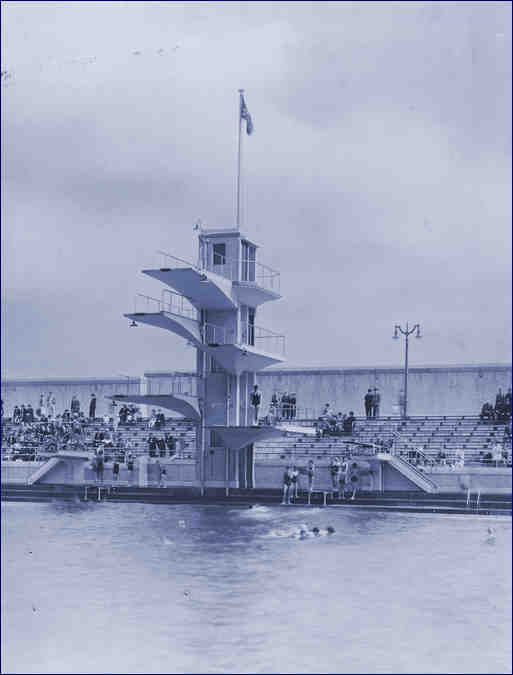
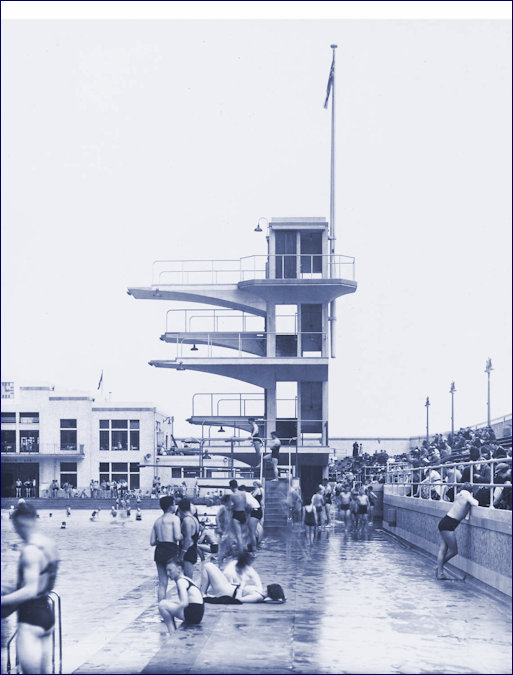
Two views of the much vaunted 32ft high diving board - the bottom image is confirmed as having been taken in 1936
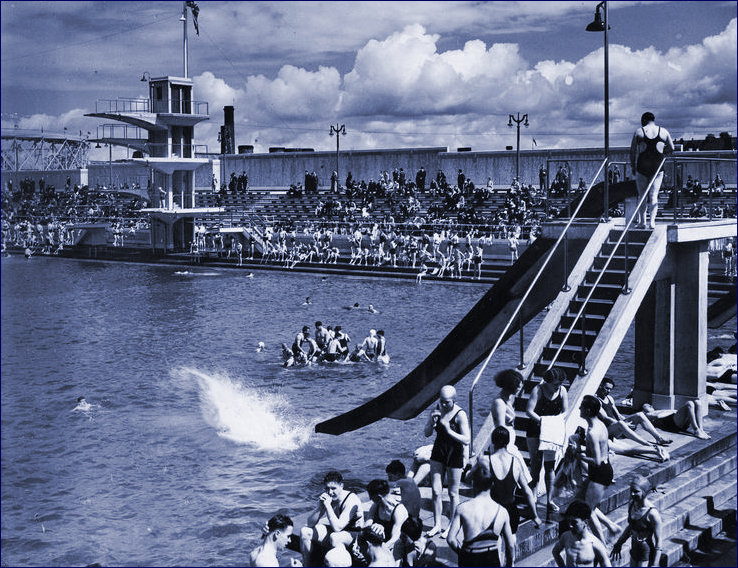
From Scotland & Swimming : Outdoor swimming is all fine and well if you are in a country with a hot climate. Scotland, however, is not known for being like that – in fact it is quite the opposite. In 1936, a brave move was made when an outdoor swimming pool was opened at Portobello, Scotland. The pool, at the time, was actually the largest outdoor swimming pool in Europe and had seating around it for 6,000 people. The Portobello pool was closed and demolished in 1988, despite much opposition from the public and despite a personal plea from Sean Connery (who had once been a lifeguard at Portobello swimming pool.)
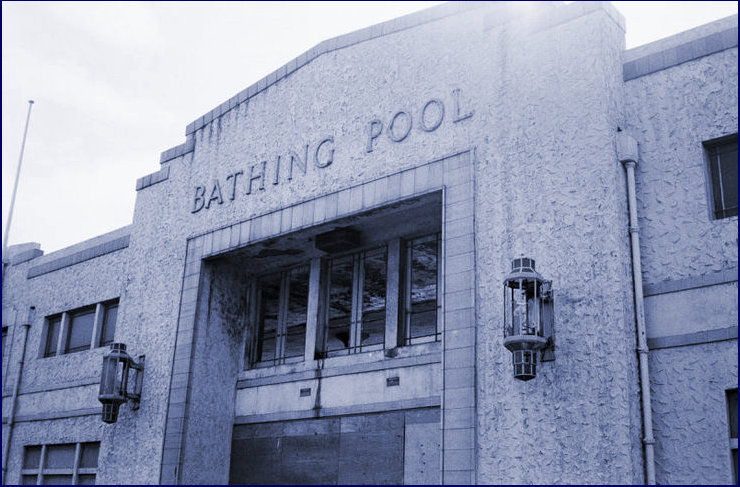
A close up of the entrance to the Bathing Pool but it already looks boarded up, at least it retains some dignity with the design above the entrance and the exterior lamps in tact.
Memory from Edinburgh Collected : Portobello's outdoor swimming pool was opened in 1936. It was equipped with diving boards and a wave machine, and was open between May and September. The pool's proximity to a power station gave it access to heated water, but also meant that it had to be covered for the duration of World War II to prevent it being used as a marker by German bombers. The actor Sean Connery served as a Portobello lifeguard in the post war period. The pool was closed in 1979, not long after the power station, and the area is now used for five-a-side football.
From historyofscotland.com : 'Portobello in the Fifties' - Portobello, Edinburgh's ‘bracing seaside resort’, with its promenade, wide sandy beach, fun fair, donkey rides and massive open air swimming pool was a thriving holiday resort at the time - the perfect setting for an enjoyable family day out. Popular with Edinburgh residents and visitors from Glasgow during the trade holidays – it would be standing room only when the sun came out.
Portobello Bathing Pool, famous for its distinctive Art Deco design, lofty diving boards, artificial waves and chilly waters, was Portobello’s main attraction for over 40 years. The pool, which opened in 1936, was the largest outdoor facility of its kind in Europe. It varied in depth from one foot to six feet two inches at the deep end. 6,000 spectators could be accommodated, with 2,000 seats available under a cantilevered stand, and there were lockers provided for 1284 swimmers. The 1.5 million gallons of water required to fill the pool was filtered from the sea and heated to a temperature of 68 degrees Fahrenheit by steam from the adjacent power station - though most accounts of the water temperature ranged from icy cold to sub-Siberian. The pool's great innovation was the first ever wave-making machine in Scotland. This consisted of four 24-feet long pistons mounted in a chamber at the deep end of the pool, which were arranged to send 3-feet high waves in three possible directions. These artificial waves were so dramatic that the machine was only operated after a warning on a klaxon had been sounded.
The Pool was closed for six years during World War Two and had to be camouflaged to stop it being used as a landmark by enemy planes. It re-opened in June 1946 and, unperturbed by the icy water conditions, the 1950s saw visitor numbers soar during the summer months with the queue to gain entrance often stretching the full length of Westbank Street. In the early part of the decade Sean Connery could be found at the Pool acting as a lifeguard. By the end of the decade, Portobello’s popularity had waned as cheap package trips abroad became more readily available and people looked for more exotic locations for their holidays. The Pool fell into a long and controversial decline, with the closure of the power station in 1978 removing what little heat there was for the water. The 1979 season turned out to be the last and demolition was finally approved in 1988.
1936 - 1976 > Super Swimming Stadium > The Midland Hotel, Morecambe
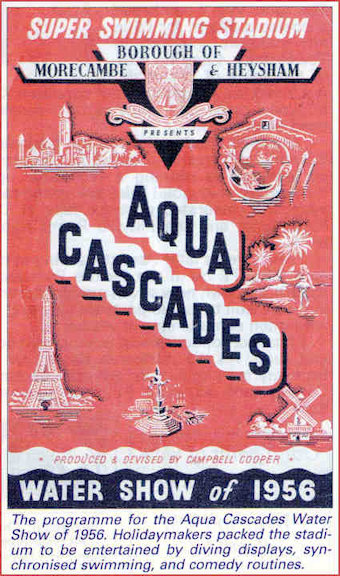
Aqua Cascades was an enduringly popular concept at Morecambe throughout the 1950s and 1960s
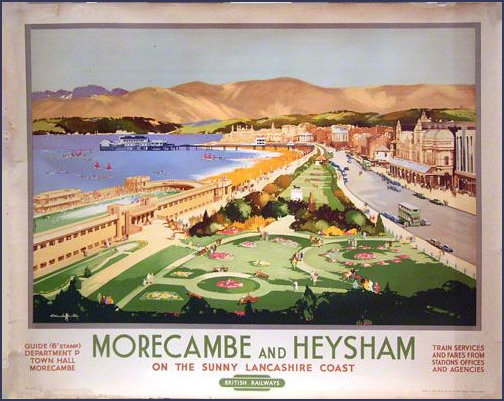
Promotional poster for Morecambe and Heysham showing the Super Swimming Stadium and Pier
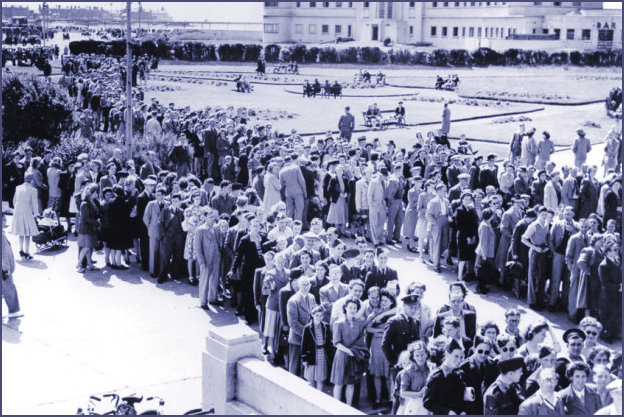
Queuing to get into the Super Swimming Stadium in the summer of 1945 for a Beauty Pageant (the Midland Hotel is in the background) - image courtesy of The Visitor
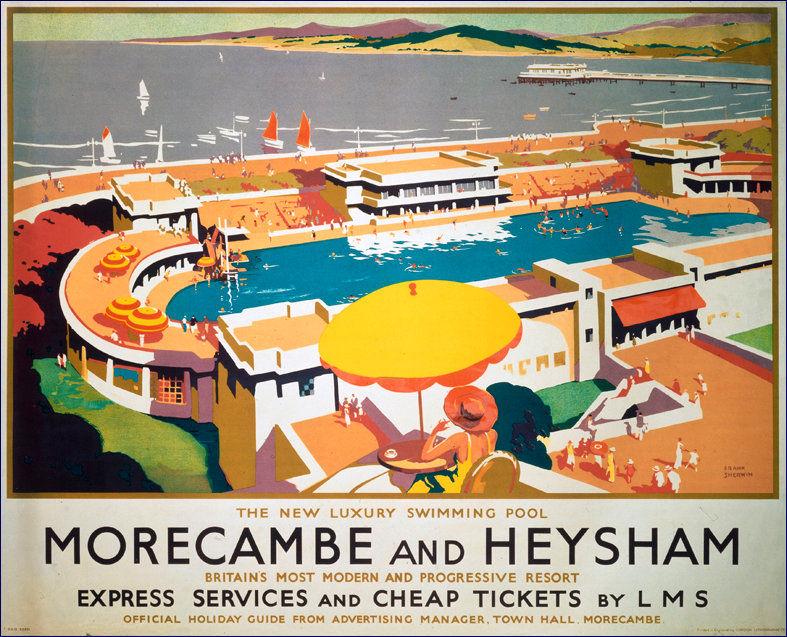
The Super Swimming Stadium as well as the bay used to promote visiting Morecambe and Heysham via LMS trains!
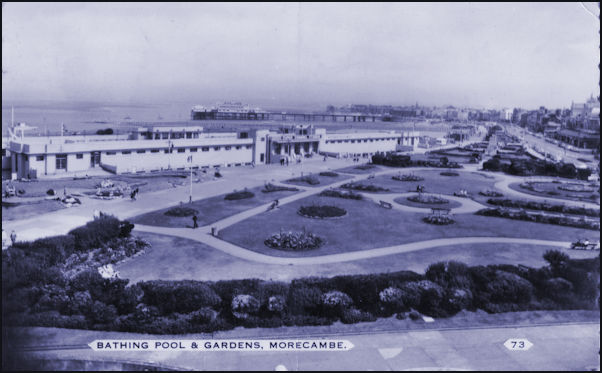
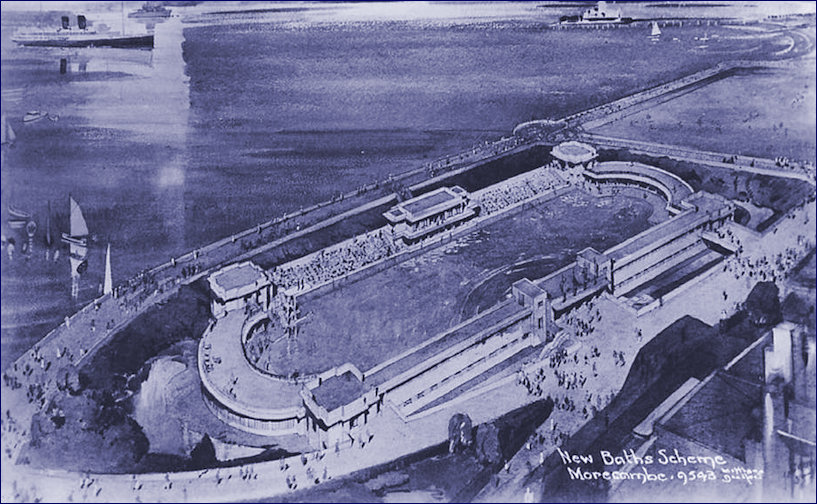
The 'New Baths Scheme' looking very much like an 'artists impression' of how the new Super Stadium would look from above
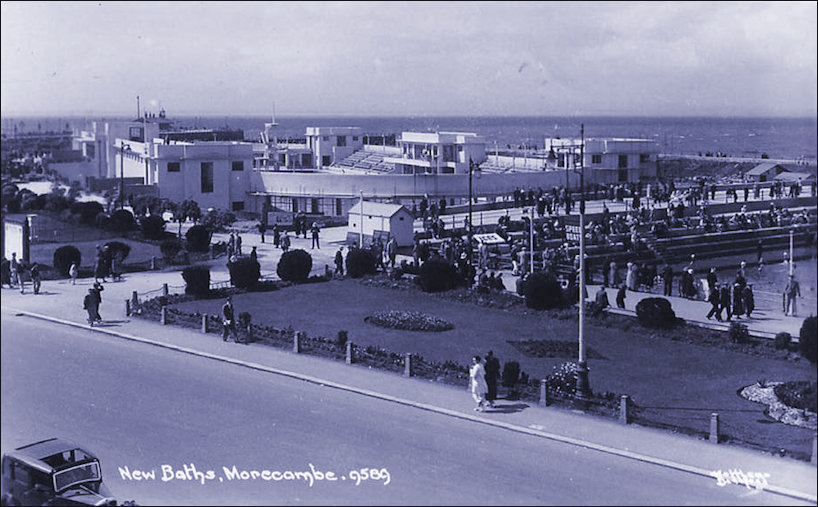
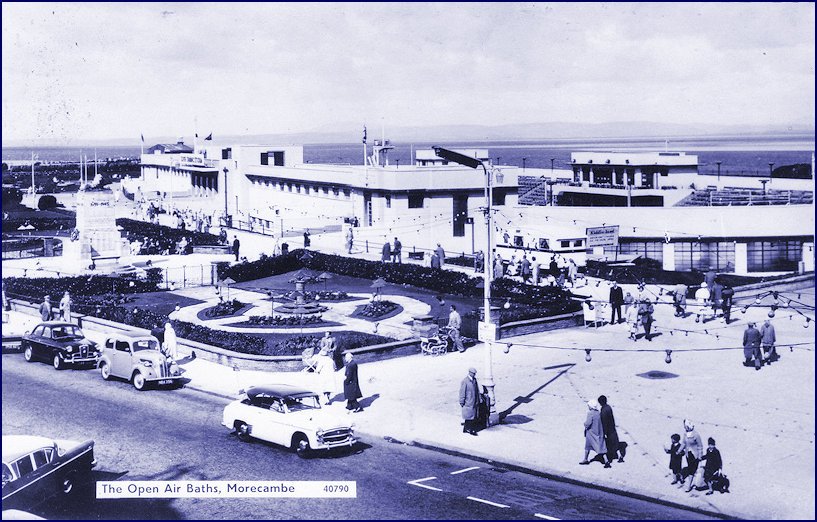
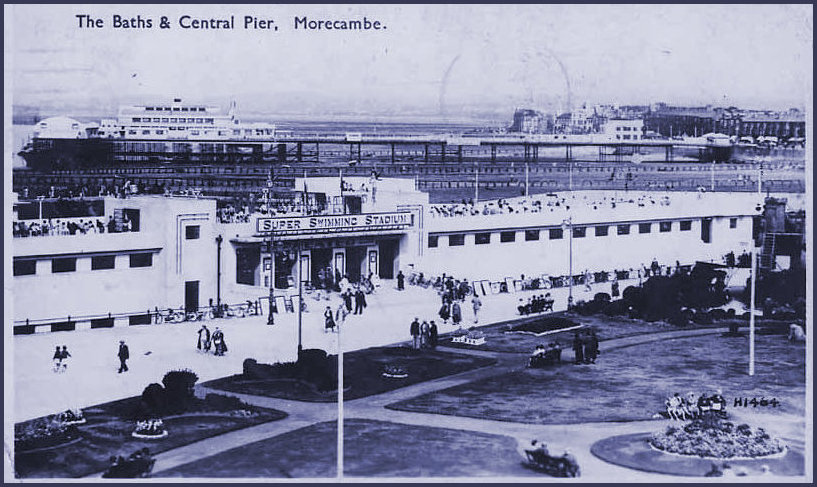
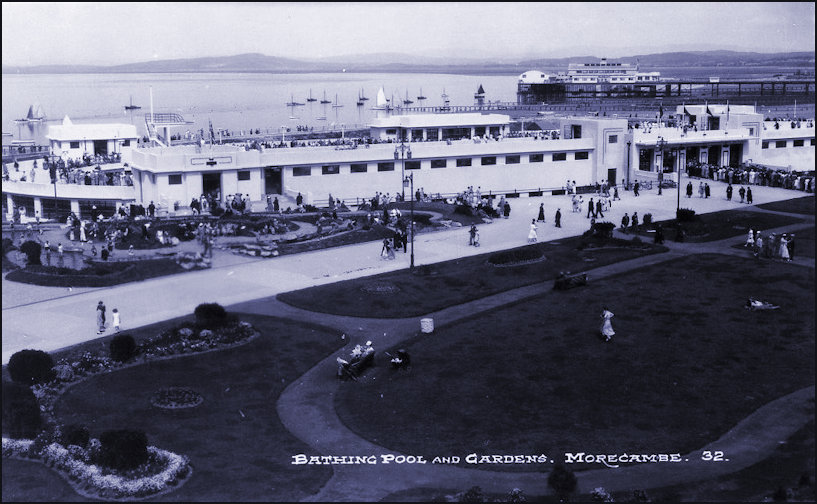
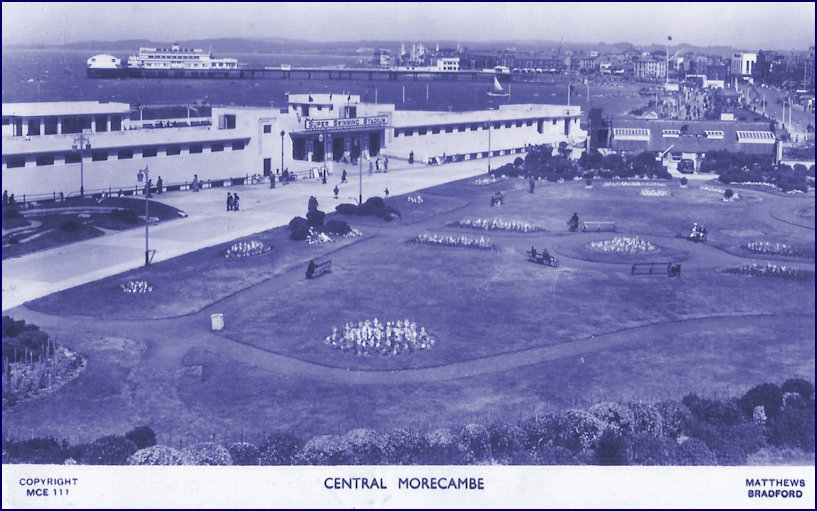
Vintage postcards showing the entrance to the Super Swimming Pool, the pier and formal gardens and in the distance the pier and Don Café
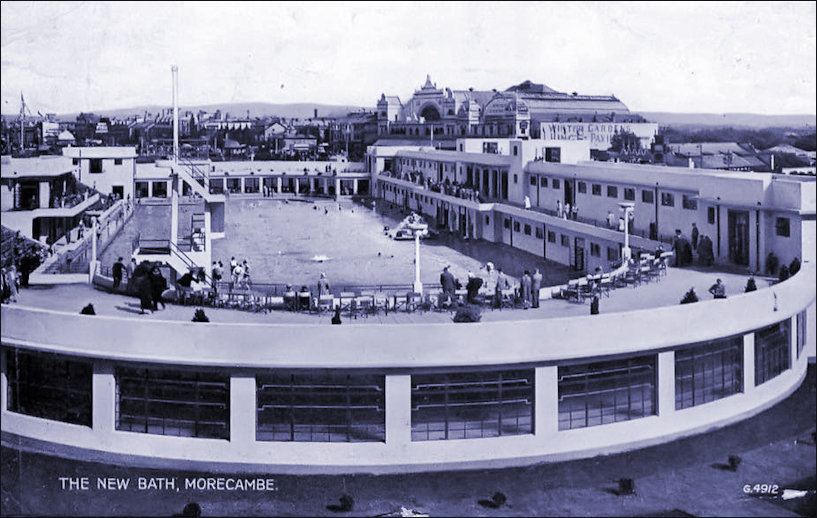
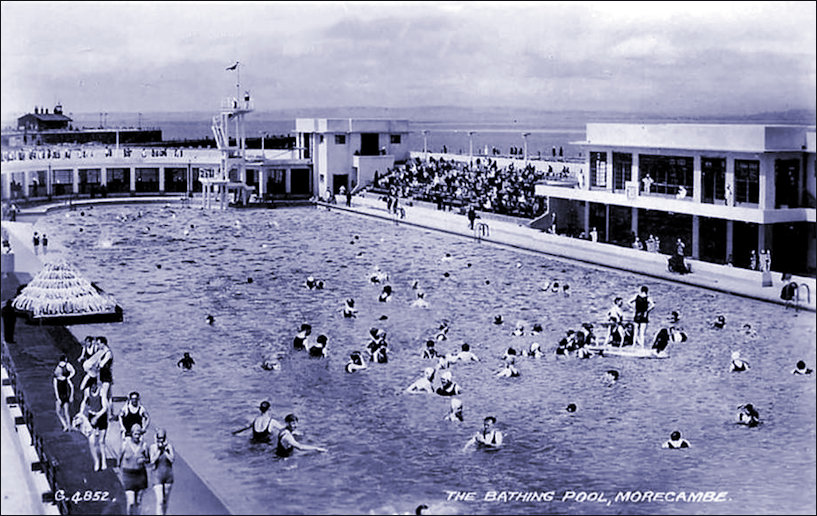
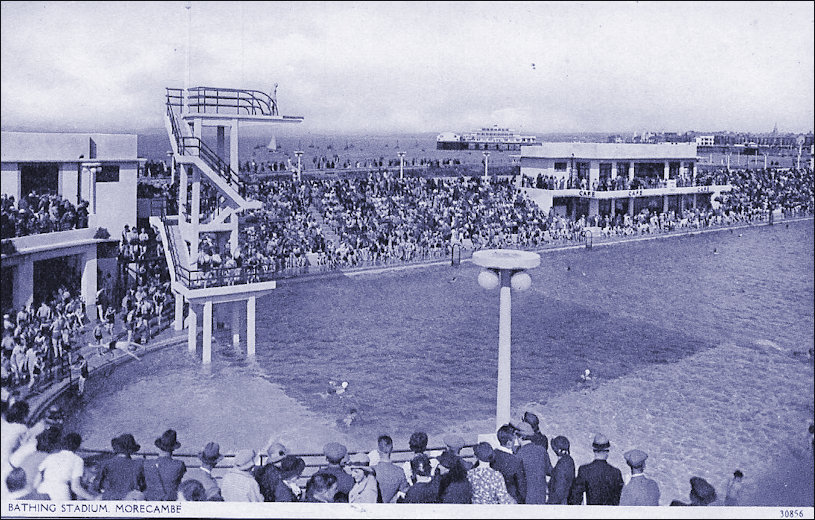
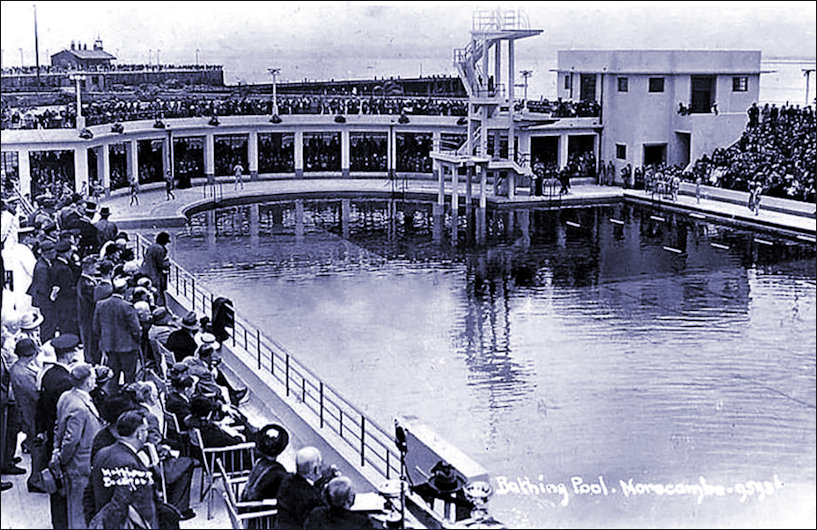
Various images of the Super Swimming Stadium as recorded on postcards - in some cases it looks as if an event is going to take place and the Stadium is full of spectators, in other views the general public are enjoying the actual Stadium for swimming and diving in. Many Miss Great Britain contests took place in Morecambe.
History
Morecambe Council also decided it needed a large outdoor pool to compete with nearby Blackpool. A new pool was built in 1936 on the site of the former ship breaking business of T W Ward Ltd. The ship breakers had long been considered an eyesore to the town, but paradoxically were something of an attraction. Many visitors paid to go on board the doomed ocean liners and warships. This time Morecambe's councillors made sure that they outdid Blackpool. The pool was truly massive, 396ft by 110ft. It was called the Super Swimming Stadium. The pool was designed by architects Cross and Sutton and built by Sir Lindsey Parkinson. The style was uncompromisingly modern. Ostensibly, it was built from reinforced concrete, like the pool at Hastings. However, 500,000 old fashioned bricks were used in the construction. The statistics of the materials used make awesome reading. As well as the bricks, there were 15,000 cubic yards of concrete, 450 tons of steel reinforcement, 2,000 square yards of granolithic flooring, 5.5 miles of pipes, 12 miles of electrical wiring and 400 lights.
Morecambe's new pool had problems right from the start. The Council was sued, unsuccessfully as it turned out, when a boy slipped on the new pool's non-slip steps and broke his front teeth. More seriously, a leak had appeared in the sea wall that formed the basin, in which the pool was set, even before construction of the pool itself began. The cause of the leak was never established and repair work never really cured the problem. This meant that sea-water could leak into the pool at high tide and the water from the pool could escape at low tide.
In spite of its problems the pool did go on to play host to the Miss Great Britain contests after the War, but was eventually demolished in the 'seventies. - Source : Seaside History
See affectionate article from Picture Postcard Monthly August 2008 here
2019 - Making a Splash - the Super Swimming Stadium remembered!
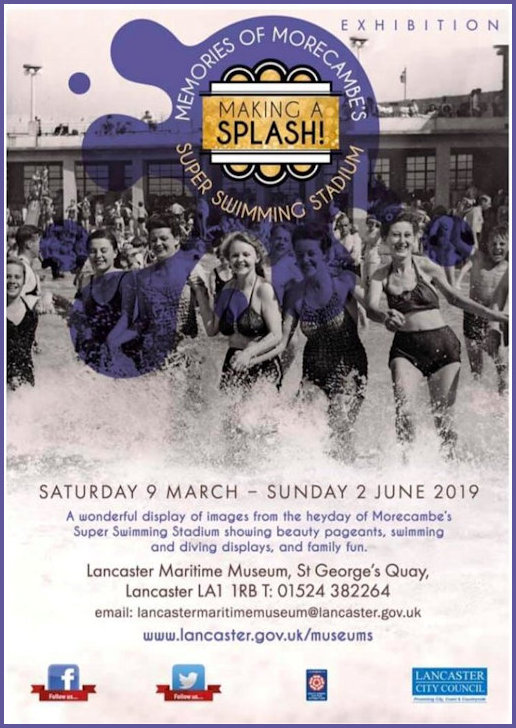
1935 - Jubilee Pool - Penzance
History
One of the most unusual and pleasing designs of the era was the Jubilee Pool at Penzance designed by Captain F Latham, the Borough Engineer. The pool was opened in 1935, the year of King George V's Silver Jubilee. It was built right on the shore line at Penzance and had to be designed to cope with the full ferocity of the Cornish seas. The pool is triangular in shape. In spite of this, straight edges have been avoided and gentle curves make it a most pleasant environment. A contemporary guide book tells us that:
"In many respects the design is unique architecturally, partly from a point of view of necessity in conforming with existing conditions of wave elements and rocks which controlled the outline. Streamlines have been used to the greatest advantage in meeting the direction of the storm waves, while a Cubist style has been adopted in the interior in providing diving platforms and steps. The whole pool is surrounded by high streamlined sea walls terraced up within the interior so as to give aspect and effect. They also serve to strengthen the structure."
The "high streamlined sea walls" also protect swimmers from strong, offshore winds and form terraces for spectators. Unlike most of the seaside lidos built in this period, the pool still stands today and is in excellent condition.
The Opening 1935
Announcing the official opening of the Jubilee Pool in The Cornishman on Thursday, 30th May, 1935
And a request from the Mayor for bunting and flags to be exhibited on the day of the opening in The Cornishman on Thursday, 30th May, 1935
The Front Page of the Cornishman dated Thursday, 6th June 1935
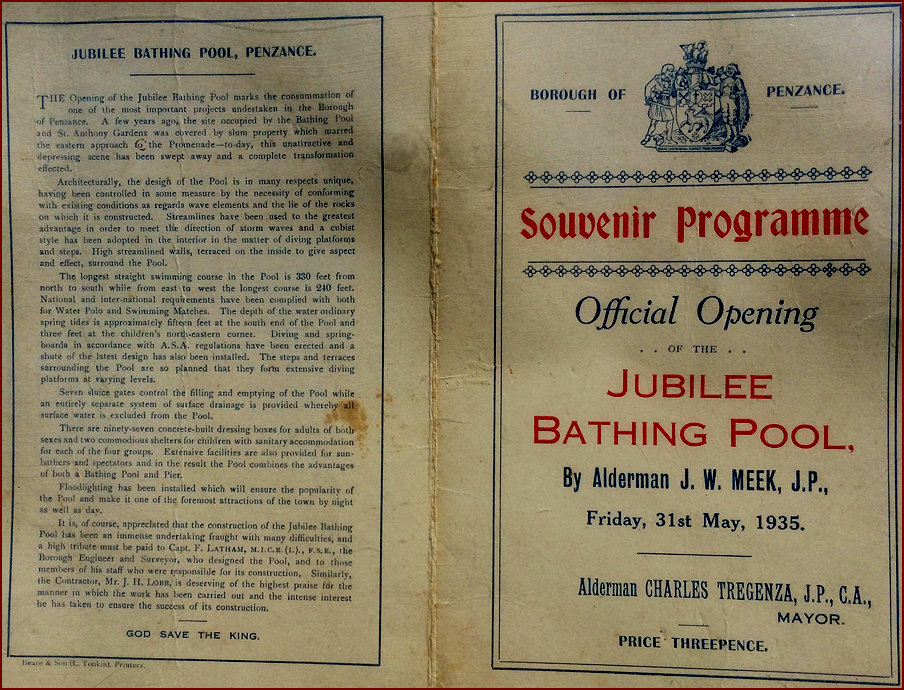
The Souvenir Programme of the Official Opening of the Jubilee Bathing Pool - likely source of image PenleeHouse.org
Official description 'Souvenir programme of the official opening of Jubilee Bathing Pool. A4 card folded in half and printed on four sides, blue print with red print for the title. Borough of Penzance coat of arms on the front page. It is to be opened on Friday 31st May by Alderman J.W Meek, with the Mayor of Penzance, Charles Tregenza J.P, C.A., by his side, and is priced a threepence. The event will include a corporate procession, the opening, singing of the National Anthem, swimming by Professor Hicks, a beauty parade of bathing belles, a programme of aquatic sports and exhibitions and music by the Penzance Silver Band, conducted by T. Proctor. On the reverse side is information about the new pool. Printer : Beare and Son (L. Tonkin) 1935 | Source : PenleeHouse.org
Narrative history on reverse of programme :
Jubilee Bathing Pool, Penzance
The opening of the Jubilee Bathing Pools marks the consummation of one of the most important projects undertaken in the Borough of Penzance. A few years ago, the site occupied by the Bathing Pool and St. Anthony Gardens was covered by slum property which marred the eastern approach to the Promenade – to-day, this unattractive and depressing scene has been swept away and a complete transformation effected.
Architecturally, the design of the Pool is in many ways, unique, having been controlled in some measure by the necessity of conforming with existing conditions as regards wave elements and the lie of the rocks on which it is constructed. Streamlines have been used to the greatest advantage in order to meet the direction of the storm waves and a cubist style has been adopted in the interior in the matter of diving platforms and steps. High streamlined walls, terraced on the inside to give aspect and effect, surround the Pool.
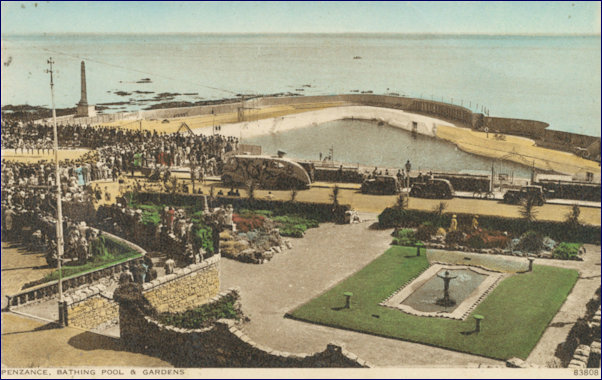
Two similar views of the Jubilee Poll in 1935 where reference is made to the St. Anthony Gardens on one but not the other - excellent array of cars visible on the road defining the era.
Another postcard view of both the Jubilee Pool and St. Anthony's Gardens with crowds enjoying the pool but no parked cars although it is likely this postcard portrays the early days.
The longest straight swimming course in the Pool is 330 feet from the North to the South while from east to west the longest course is 240 feet. National and inter-national requirements have been complied with both for Water Polo and Swimming Matches. The depth of the water ordinary spring tides is approximately 15 feet at the south end of the Pool and 3 feet in the children’s north-eastern corner. Diving and spring-boards in accordance with A.S.A. regulations have been erected and a shute of the latest design has also been installed. The steps and terraces surrounding the Pool are so planned that they provide extensive diving at various levels.
Seven sluice gates control the filling and emptying of the Pool while an entirely separate system of surface drainage is provided whereby all surface water is excluded from the Pool.
There are ninety-seven concrete-built dressing boxes for adults of both sexes and two commodious shelters for children with sanitary accommodation for each of the four groups. Extensive facilities are also provided for sun-bathers and spectators and in the result the Pool combines the advantages of both a Bathing Pool and a Pier.
Floodlighting has been installed which will ensure the popularity of the Pool and make it one of the foremost attractions of the town by night as well as day.
It is, of course, appreciated, that the construction of the Jubilee Bathing Pool has been an enormous undertaking fraught with many difficulties, and a high tribute must be paid to Capt. F. LATHAM, M.I.C.K. (I.), F.S.E., the Borough Engineer and Surveyor, who designed the Pool, and to those members of his staff who were responsible for its construction, Similarly, the Contractor, Mr. J.H. LOBB, is deserving of the highest praise for the manner in which the work has been carried out and the intense interest he has taken to ensure the success of its construction.
GOD SAVE THE KING
The language used is remarkable and some of the spelling uses hyphenation long lost today (to-day), a wonderful piece of encapsulated history and I have retained the typographical errors as on the original.
As the Pool and the Yacht Inn are inextricable as far as I am concerned the images below, mostly from unsourced postcard images will include both structures.
Newspaper clipping dated 1957
Lido design
By the mid 'thirties a standard formula for lido design had emerged. Most pools were rectangular, although oval shapes were also common. Decks for sunbathing and separate cafés for bathers and spectators were also provided. The most important of the lido's buildings was the engine room that kept the pool fed with clean water. Much was made of the purity of water in new pools by guidebooks and contemporary advertising, suggesting that this was not always the case. Most pools of the era had a cascade or fountain. On hot days bathers could climb on to it and watch other swimmers. The fountain also served to aerate the water. Slides were also featured, a double slide or water chute was provided at the Skegness Pool. The diving boards though, were perhaps the most stylish of the features. Some pools had very elaborate diving platforms. The one at Western-super-Mare had a semicircular platform to which boards at varying heights were mounted. This pool also had the unusual feature of a gently sloping beach area. It was though, in other respects conservative for a pool built in 1938, for the classical style was used in preference to the modern. - Source : Seaside History
Restored Battery Rock facing wall of the Lido - Photograph: Matt Cardy/Getty Images
From the Guardian :
Making a splash: Penzance's Jubilee Pool reopens
Bathers enjoyed a bracing swim in one of Europe’s few remaining saltwater lidos when Cornwall’s Jubilee Pool reopened at the weekend (19th July 2016) following a £3m restoration.
When you think of Cornish landmarks, a 1930s cubist-inspired lido is probably not the first thing that springs to mind. But judging by the crowds of locals and intrigued bank holiday visitors who turned up to the reopening of Penzance’s Jubilee Pool on Saturday, it could soon be added to the list of the county’s well-known attractions. Jutting out from the town’s harbour into the sea, the triangular engineering of the pool – designed by Captain F Latham, the borough engineer – sought to streamline its outline and offer the best chance of surviving the brutal south-westerly storms that batter the Cornish coast in winter.
The design proved fit for purpose for decades until the freak winter storms of 2014, when the waves breached the walls and twisted railings, and demolished changing rooms and terraces, while exposing the granite that lay beneath the pool.
The community and local government rallied around the cherished bathing spot and government finance for the £2.94m in essential restoration work came via the Coastal Communities Fund, as well as a mix of local government bodies and groups. Work has included securing the pool platform to the bedrock with rock anchors, stabilising and repairing changing rooms, paving and handrails, as well as upgrading the drainage.
One of the reasons so many people have gone to so much trouble to ensure the lido’s survival is that it is one of only a handful of saltwater tidal pools left in Europe. “When it was built in 1935, to commemorate King George V’s silver jubilee, the council wanted to put Penzance on the map by building a state-of-the-art facility, which people would want to use,” says Martin Nixon, head of the Friends of the Jubilee Pool community group. The 1930s was a golden age for lidos in the UK, as outdoor swimming became a national obsession. The pool’s appeal suffered a blow in the 1970s when package holidays began to offer a much warmer alternative, and by the early 1990s it had become neglected enough for the council to consider whether further investment was viable.
But on this overcast May bank holiday weekend, you would be forgiven for thinking that the obsession has never gone away. People were queuing patiently along the harbour wall to get their first glimpse of the pool’s substantial makeover, and there was a buzz around the town as young and old flocked with beach bags and towels towards their revamped harbourside pool. But why were people queuing, when just miles away there are some of the best beaches in the country? “This has always been Penzance’s concrete beach and there’s a massive local affection for what it represents,” says Nixon. “It’s got a different vibe from a beach, it’s communal, and generations of local people have learned to swim here, have fun here, and even dated here. It’s a social melting pot that you just don’t get at the beach.”
Its triangular shape and high walls were supposed to protect it from the waves, but the lido had to close after suffering major storm damage in 2014.
That melting pot ideal was apparent from the unexpected acoustics of the architecture, which mixed yelps of wetsuited youths jumping into chilly waters with the hum of hardier generations braving the pool in just trunks and swimming costumes. Bigger groups chatted over picnics on the terraces and by the licensed poolside cafe, which offers snacks and full meals. The plan is to make good use of these acoustics by covering the children’s pool with a temporary platform on summer evenings, and turning it into a mini amphitheatre for local bands. As well as concerts and gigs, stand-up paddleboard lessons are being trialled as another way to make use of the location and generate income. All of which, the lido’s guardians hope, will ensure that the Jubilee Pool never goes out of style again.
One of the few remaining art deco lidos in Britain reopens on 28 May after a £3m refurbishment. Penzance’s 1935 Jubilee Lido is the UK’s largest surviving seawater pool. To mark its reopening there were free swimming sessions on the day. Photograph: Adam Gibbard
Read more : Visit Cornwall | Daily Mail | Seasalt Stories (Campaigners) | Municipal Dreams | Cornwalls
1934 - New Brighton Open Air Bathing Pool
Seeing the word 'Brighton' may make you think that this Open Air Swimming Arena was situated in the deep south of England, but despite its name, the location of this lido is in the other hugely popular area of the North West! It helps that LMS stands for London, Midland & Scottish Railway running up the West side of the country. The Lido is situated in Wallasey (on the Cheshire Coast) which is somewhere in the now all-encompassing Wirral - for students of serious historical research visit the History of Wallasey website the story of this Lido is comprehensively covered and has some wonderful records (all unfortunately ruined by copyright notices).
The original lido was opened in June, 1934 by Viscount Leverhulme and cost the old Wallasey Corporation more than #90,000. In the first two months after opening, more than one million people passed through the turnstiles. The pool itself could accommodate 2,000 swimmers and there was seating for 10,000 spectators. By the 1950s, the pool was attracting around 150,000 people on a bank holiday weekend but its popularity declined and in the 1980s it was closed and put up for sale. In 1990, it was almost destroyed when a massive storm breached the sea wall and Marine Promenade was flooded. - Source : Daily Post
Sun, sea and Cat in New Brighton or alternatively a bucket, spade and scarf to entice visitors now being ferried by British Railways - somehow the original 1930s posters were a little bit more classy than these 1950s efforts!
A full panorama of the Lido (undated) courtesy & © of roydutton.co.uk
Postcard of the Lido dated 1935 - artists impression?
Postcard postmarked 1935
A postcard of the Lido in 1936
A magnificent view of the design - New Brighton Bathing Pool 1934. Source & © : Merseyside Maritime Museum / courtesy Wallasey Local Studies Library via the Liverpool Echo
The feature fountain - looks as though this could be part of the opening ceremony in 1934 - image courtesy of the Liverpool Echo
Floodlit at night in 1947 - Source Pininterest
General view (undated) - New Brighton Lido from the archives of Stewart Bale Ltd via the Liverpool Echo
Storm Damage in 1990 led to the demolition of this Art Deco Treasure! - New Brighton outdoor swimming pool is demolished in 1990 via the Liverpool Echo
1932 - Grange Lido, Cumbria
Official Opening - 18th August 1932
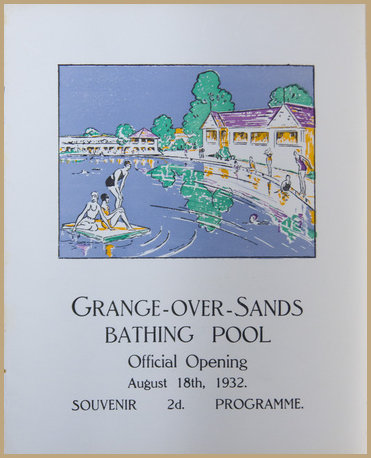
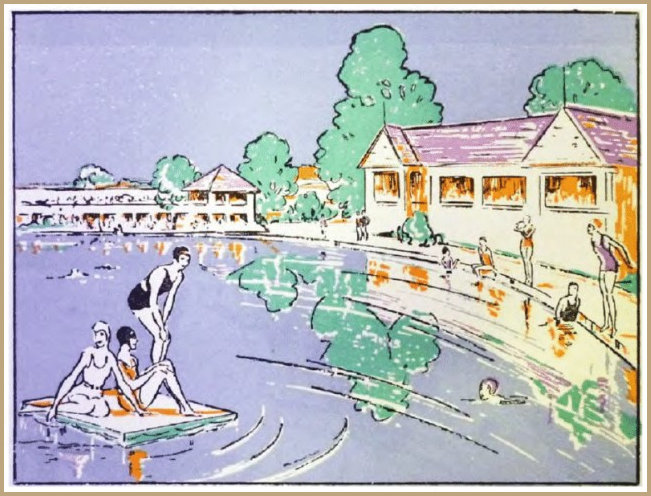
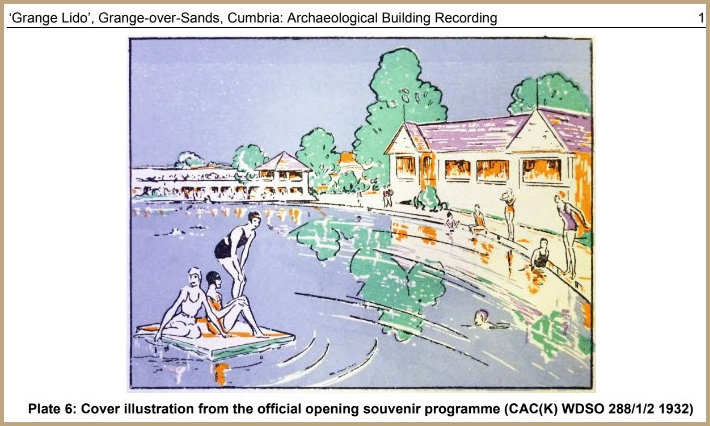
Beautifully preserved images of the souvenir programme produced for the opening of Grange Lido on 18th August 1932 images sourced from grangeoversands.weebly.com and the Conservation Statement (downloadable in .pdf format)
Conservation Statement (detail)
Summary of Building A seaside salt-water lido constructed in 1932 to designs by the Council Surveyor Bernard Smith. It is complete with all key ancillary buildings including an entrance block with upper viewing gallery and attached sun decks, detached changing wings, terraces, pump house, paddling pool and stepped diving stage. The slide and diving boards have been removed. The lido closed in c. 1993. Reasons for Designation Grange over Sands Lido constructed in 1932 is listed at Grade II for the following principal reasons: * Completeness: as a complete example of a 1930s lido with the survival of all key ancillary buildings and structures * Pool: for the unusually shaped pool, designed for multiple uses and which retains its original stepped diving stage. * Historic: as an evocative reminder of the former popularity of sea-side towns such as Grange over Sands and the inter-war cult of fresh air, fitness and mass leisure.
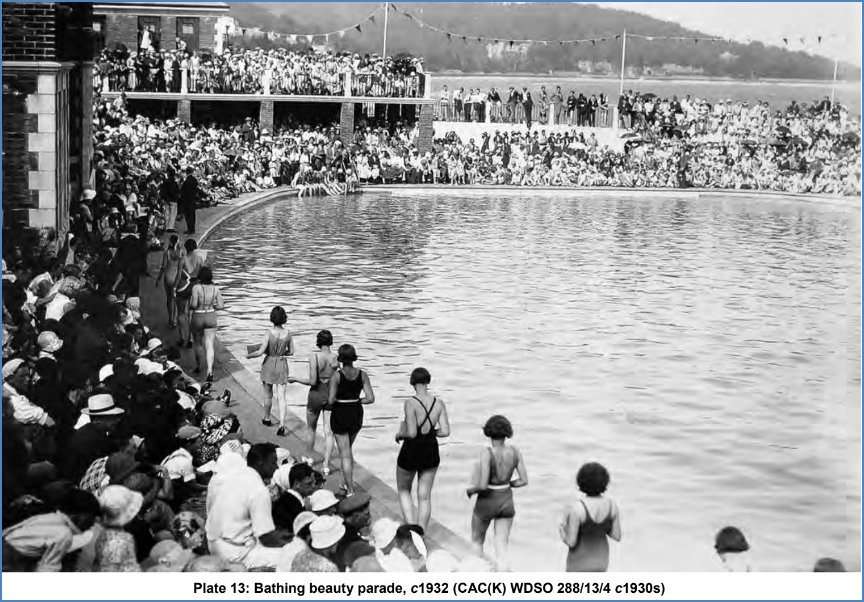
A popular event very early on in the history of Grange Lido by the looks of it - the eternal Beauty Pageant so beloved of the 1930s - images sourced from the Conservation Statement
History
The arrival of the railway in 1857, transformed Grange over Sands from a small fishing village to a popular seaside resort lying on the north side of Morecambe Bay, with the promenade developed just after the turn of the C20. The lido, accessed off the promenade, was constructed in 1932 to a design by Mr Bernard Smith, Grange over Sands Urban District Council Surveyor. Inter-war lidos characterise the period in their combination of design flair, outdoor leisure and devotion to the cult of sea, sun and fresh air. The pool was unheated and filled with filtered water taken from the sea at high tide. Photographs taken of the lido in the 1930s and 1960s demonstrate its popularity for both swimmers and spectators alike, and depict the original slide and diving boards which were removed in the second half of the C20. The lido closed in 1993. Since the lido was built, shifting tidal currents have moved the sea a significant distance to the east and it is now separated from the lido by a broad area of marshland, which covers the former beach. Details Lido. 1932 by Bernard Smith, Grange over Sands Urban District Council Surveyor MATERIALS: Concrete with brick ancillary buildings with concrete dressings; slate roof coverings PLAN: Pool set in a roughly semi-circular enclosure with splayed sides, with an entrance building in the centre of the landward side, flanked by sunbathing terraces with separate men's and ladies' changing room blocks at either end. A small pool, probably a children's paddling pool is set to the north side with a pump room and a diving stage at the centre of the east side, flanked by stepped terraces. POOLS: The focal point of the lido is the bathing pool, shaped to resemble the cross section of a mushroom, sloping down to the east with the narrower stalk forming the deep end. Adjacent to the deep end there is a single-storey rectangular shaped pump house, with an attached arched, 5-level diving stage (diving boards removed). Steps flanked by iron railings lead up from the poolside to the flat roof of the pump house where access was formerly gained to the diving boards. Either side of the diving stage, stepped seating curves around the south-east and north-east sides of the pool. A small children's paddling pool is situated immediately east of the ladies' changing rooms
Historic Pools of Britain
Grange Lido, Cumbria
Name: Grange Lido
Location: Grange-over-Sands, Cumbria
Current status: Closed
Date built: 1932
Architect: Bernard Smith (the council surveyor)
Listed building status: Grade II
Lead organisation: Save Grange Lido
Description
A very fine intact Art Deco mushroom shaped lido in a stunning setting on the edge of Morecambe Bay just south of the Lake District National Park.
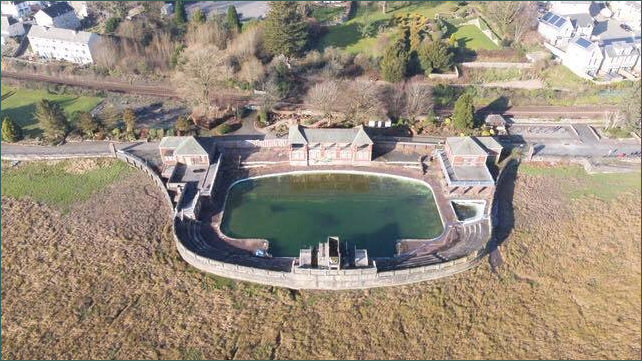
It really does look like a mushroom doesn't it? No wonder people remark on it - image sourced from Save Grange Lido Fb
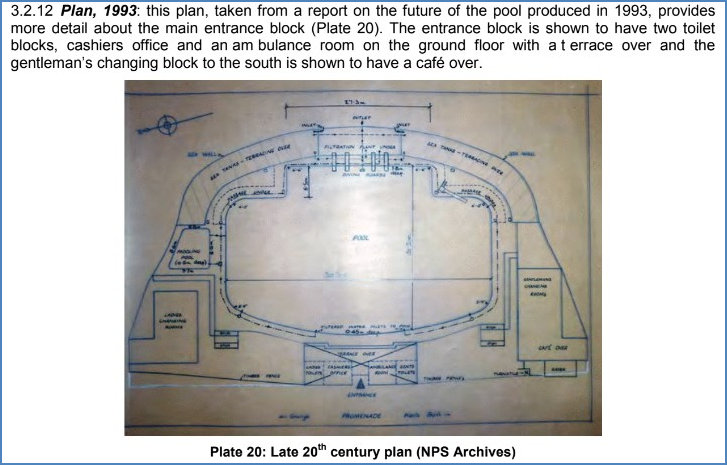
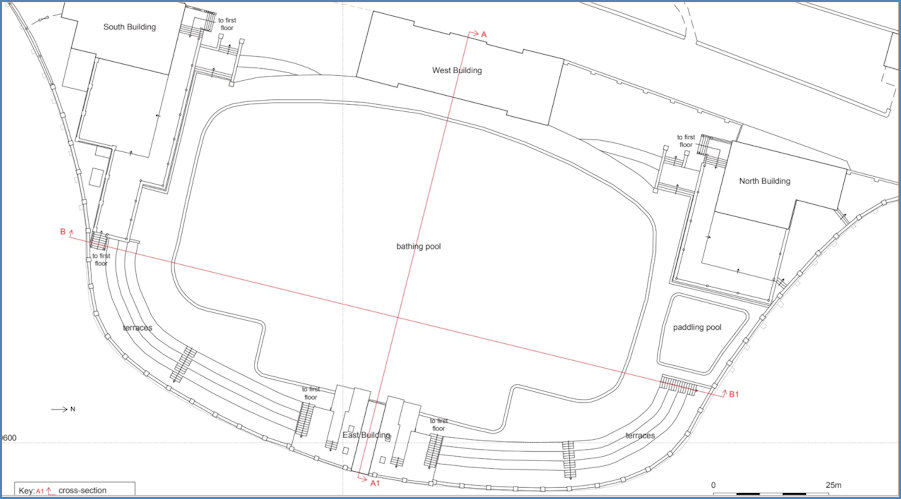
Both groundplans sourced from show the Conservation Statement celebrated 'mushroom' shape that always appears in any description of the Lido.
Facilities
The pool is 50m long and bordered by an entrance block with upper viewing gallery and attached sun decks, detached changing wings, terraces, pump house, paddling pool and a stepped diving stage.
Notable facts
Grange-over-Sands was transformed from a fishing village to a popular resort following the arrival of the railway in 1857. In the 1930s every self-respecting seaside town had a Lido but almost all of them have been demolished – Grange Lido is the only one of its type left in the North of England. The lido closed in 1993 and its fate has hung by a thread ever since.
Current plans
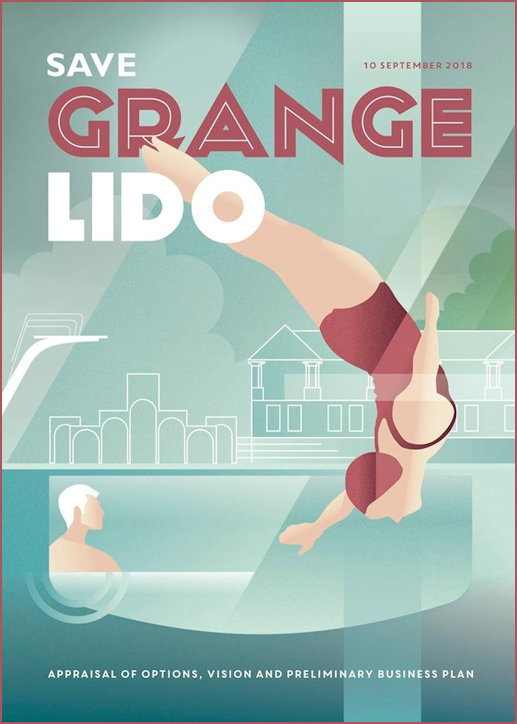
21st century artwork evoking the 1930s - image sourced from Save Grange Lido Fb
Local people overwhelmingly support the re-opening of Grange Lido. Save Grange Lido formed in 2011 and secured the listing of the Lido. It has a clear vision and Business Plan which demonstrates how the lido could benefit local residents, visitors to the area and the local economy. The next stage is to convince the local council that an operating Lido is preferable to filling it in. The Council has earmarked £1.8m for restoration of the site and further funding is being sought.
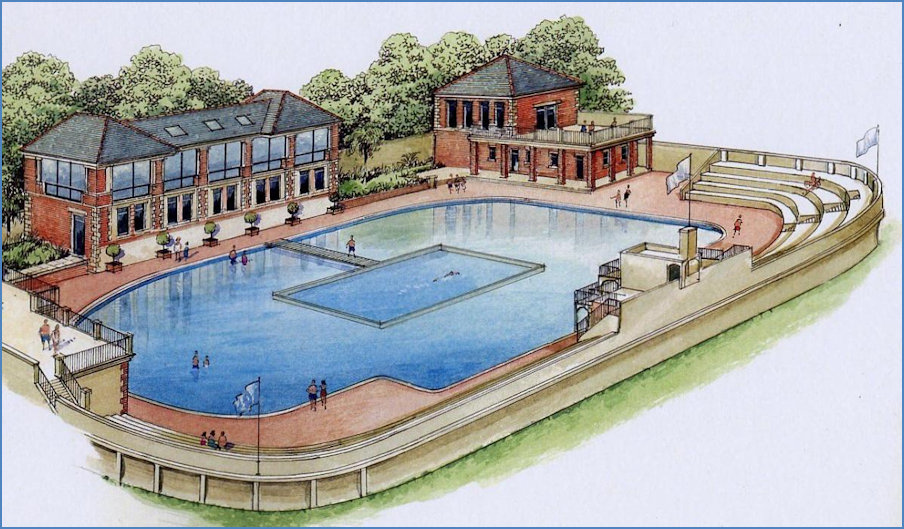
Very popular project with the locals who thoroughly approved (81%) the proposed renovations in this artists impression as seen in the Westmorland Gazette dated as far back as 2017!
Timeline :
A very comprehensive document entitled 'Swimming in Grange, Time Line of the Grange-over-Sands Lido 1932-2018' has been produced by the Save Grange Lido Campaigners and can be found following the link above or downloading the .pdf file here
1992 - 60th Anniversary

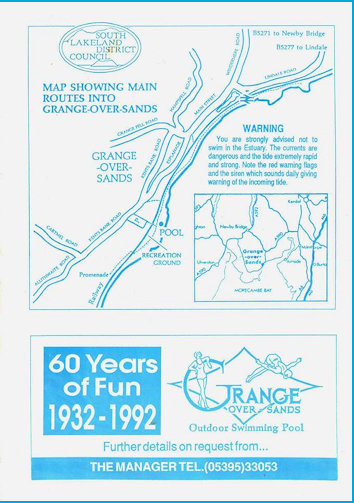
1932-1992 60th Anniversary brochure - sourced from Save Grange Lido Fb
1923 - 1933 : Blackpool - When is a Lido an indoor Swimming Pool?
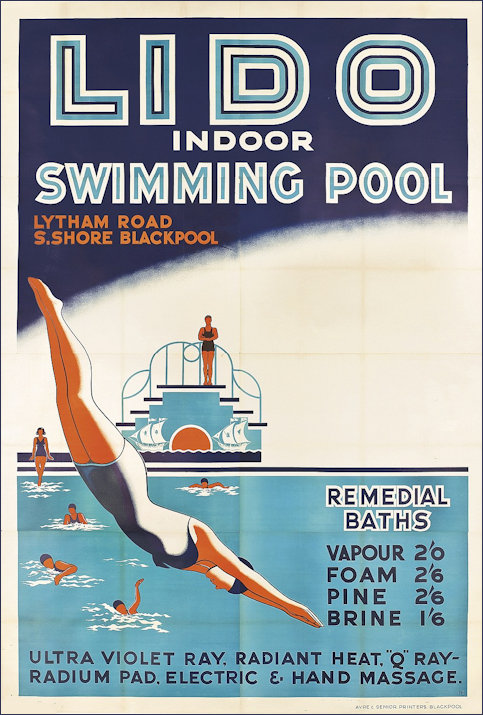
Advertised as a 'pre-war poster' this wonderful piece of history is expected to sell for over £1,000 at auction - image courtesy and sourced from Fleetwood Weekly News
I'll speak plainly - this puzzle has me flumoxed, is this an indoor swimming pool or an outdoor Lido? Definition of lido - 'a public open-air swimming pool or bathing beach.'
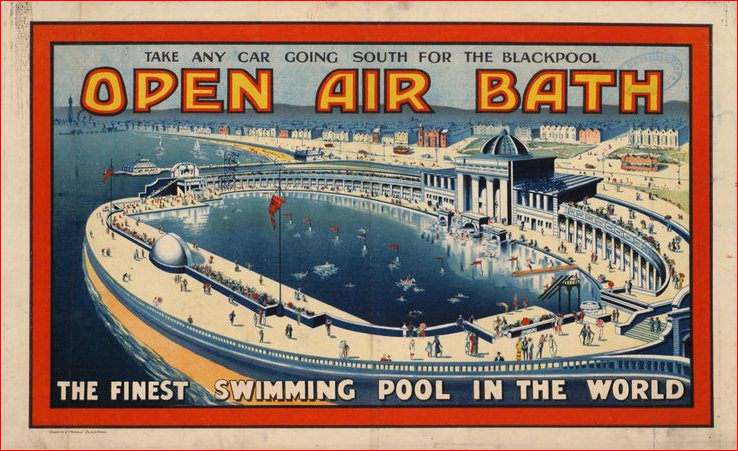
And what is an Open Air Bath - is this the 1923 'Lido' mentioned above? Image sourced from Pinterest
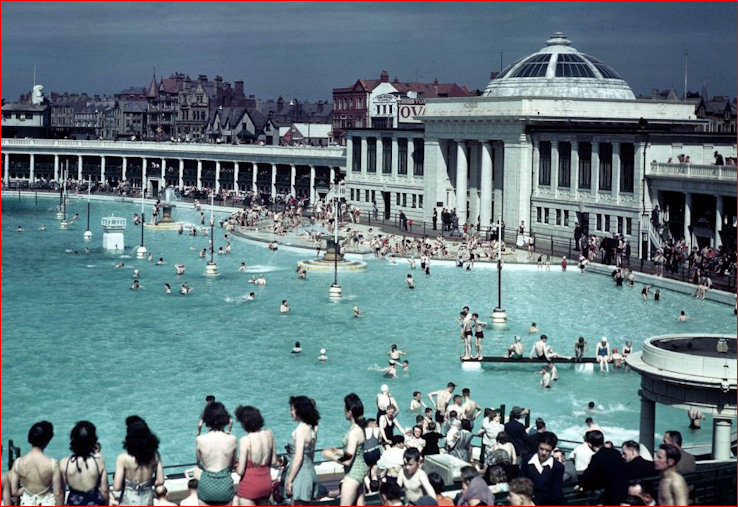
This has been mis-identified as the 'Imperial Hotel' - image sourced from Pinterest but likely to be a Getty image
I think we are dealing with two separate but intriguing locations, the poster referred to at the beginning of this conundrum is a genuine piece of Art Deco artwork created in 1934. The open air swimming pool now identified does not bear the name of 'Lido' but is such in terms of the definition of the word. The Fleetwood Weekly News have provided some erroneous background to the sensational sale mixing it up with the Open Air Baths which did open in 1923 :
Pre-War Lido Poster Goes Under Hammer
Read more at: http://www.fleetwoodtoday.co.uk/news/pre-war-lido-poster-goes-under-hammer-1-7267677
Read more at: http://www.fleetwoodtoday.co.uk/news/pre-war-lido-poster-goes-under-hammer-1-7267677
Read more at: http://www.fleetwoodtoday.co.uk/news/pre-war-lido-poster-goes-under-hammer-1-7267677
- Rare pre-war poster is set to fetch around £1,000 at an auction in London
- It is advertising Blackpool’s Lido Indoor swimming pool
- Blackpool was one of the first resorts to build a Lido
- Splashing out, what was then, a staggering £75,000 on a new pool, which opened in 1923
- At 376ft by 172ft, it was wider at its extremities than a modern Olympic pool is long
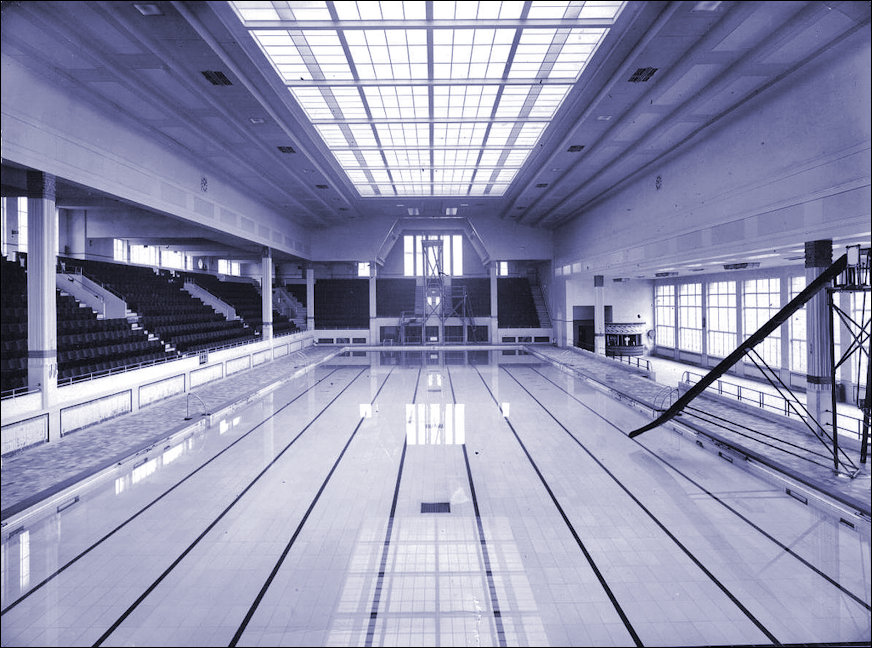
The wider than an Olympic Swimming pool in the Derby Baths - image sourced from picssr.com - from other angles the expanse of the seating really does place this as an auditorium-like venue
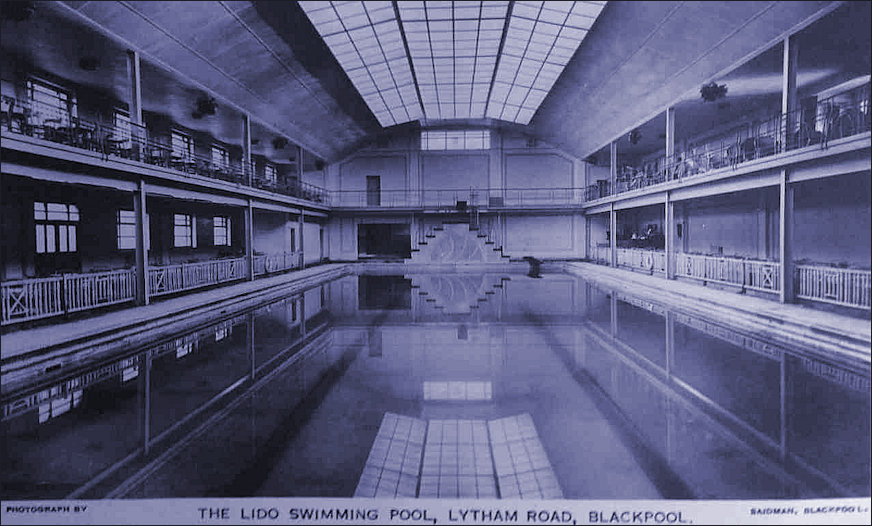
This image was kindly sent to me by e-mail without the sender offering a name or why it was sent - needless to say I am very grateful and thank them via this acknowledgement. It certainly has the look of a contemporary postcard.
A rare pre-war poster, advertising Blackpool’s Lido Indoor swimming pool is set to fetch around £1,000 at an auction in London. The massive 116-inch by 78-inch poster,which is on 10 joined sheets backed on linen, was printed by Ayre & Senior, who, in 1934, were based in Carter Street, Blackpool. It is emblazoned with the words ‘Lido Indoor Swimming’ which was the ‘remedial baths’ available at the Lido. Long before the invention of whirlpools and before showers became commonplace, it was possible to go to the Lido for a “brine bath” which, in those days cost only one shilling and sixpence (about 8p in modern money).
More affluent customers could pay two shillings and sixpence (about 13p in modern money) for a vapour bath, a foam bath or a pine bath. According to the poster, the Lido, at Lytham Road, also offered “ultra violet ray” treatment and even more temptingly “a hand massage”. Blackpool was one of the first resorts to build a Lido and splashed what was then a staggering £75,000 on a new pool, which opened in 1923. At 376ft by 172ft it was wider at its extremities than a modern Olympic pool is long.
The Blackpool Gazette described its architecture as “Renaissance” and its style was strongly influenced by the classical. A costume could be hired for a threepenny bit (about 1p) and a cap or a towel for just one old penny. The pool could accommodate 1,500 bathers and had changing rooms for 600. The Lido poster is expected to sell for between £800 and £1,200 at Christie’s South Kensington on June 4. Read more
The Birmingham Daily Gazette dated Friday, 10th November 1933 tells us :
"BLACKPOOL "Lido Swimming Pool" to be Provided Blackpool. most progressive of all seaside resorts, is to take the lead again with an elaborate new everyday attraction for its visitors in the form of a luxurious covered swimming pool, a project of local and private enterprise. The new " Lido swimming pool " will be of championship size, and in advance of any similar bath in this country. As well as the 190 ft by 491 ft. pool there will be slipper, foam and remedial baths. The most recent ideas of filtering and heating will be incorporated. The size of the Lido building can be judged by the fact that the frontage will accommodate eight shops. A promenade, lounges, cafes, and a ballroom will be other attractions of this building. A solarium has been set apart fur sun bathing and sunray treatment. The pool will remain open throughout the year." Source : British Newspaper Archive
Remarkable wrought iron detail at the entrance area of the Derby Baths - image sourced from Flickriver
Plaque commemorating the opening of the Derby Baths - image sourced from Flickriver
Even after all this and mentions of the demise of the lido in 2006 courtesy of the Blackpool Gazette who state "GENERATIONS of Blackpool families have learnt to swim in it. But Blackpool's Lido pool will soon disappear from South Shore's landscape. Demolition work is well under way at the 1930s pool which has been replaced by swimming facilities at the 6.5m Palatine Leisure Centre on St Anne’s Road. The site is being cleared to build a 2.5m enterprise centre aimed at building on opportunities arising from Blackpool's master plan. Coun. Eddie Collett, cabinet member for tourism and regeneration, said the work was the latest sign that things were really changing for Blackpool." I have still been unable to source any exterior images of the 'Lido' swimming pool and that's because I think it is now popularly referred to as the 'Derby Baths' otherwise everything would have been built in 1923 in Blackpool with designs way ahead of their times. So taking that into account I am going to focus on the 'Derby Baths' building rather than the Lido and will call the Open Air Swimming Baths by that title rather than as a Lido - ergo - Blackpool have no and never have had a Lido .....
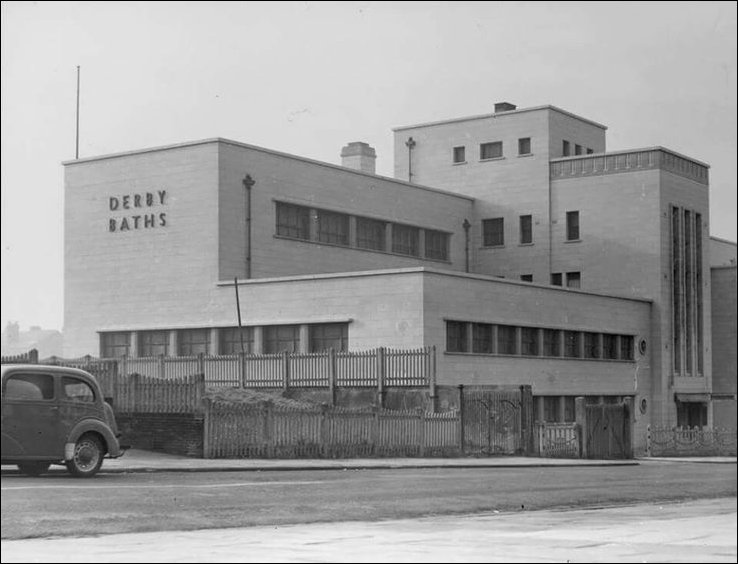
This image sourced from Pinterest
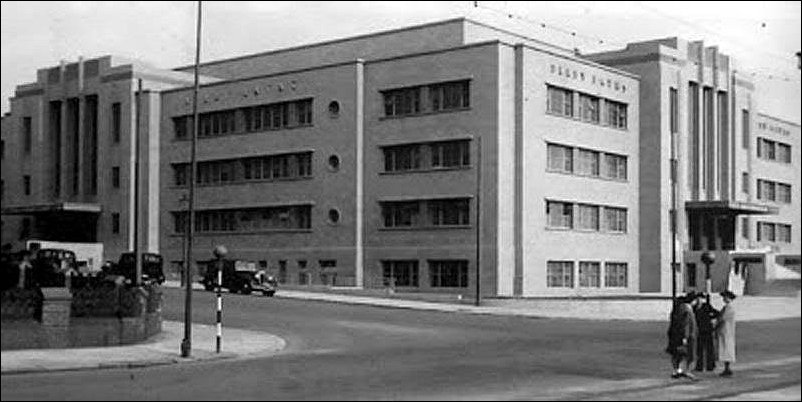
This certainly has the start of a Streamline Moderne look about it and the cars and people's clothing, on the images, certainly attest to very early 1930s if not late 1920s - this image sourced from reddit lost architecture
Returning to the 'Open Air Bath' - widely accepted as a true 'Open Air Swimming' area, therefore within the strict guidelines of a Lido, the now defunct practise of beauty pageants was a popular past time in this location!
So who was the poster (remember, designed in 1934) created for? It's a bit of a mystery as the Derby Baths with their Olympic sized pool wasn't opened until 1938 and as can be seen is a fabulous piece of architecture. The Blackpool Civic Trust states :
Derby Baths
"As the loss of the Palace fades from memory, that of the remarkable Derby Baths, which stood at the corner of the Promenade and Warley Road until 1990, has replaced it as the most often mentioned. Its demolition was hugely controversial at the time, but an attempt to have it listed failed. Photographs speak for themselves – it should never have happened."
The Guardian ran an article entitled 'What were they thinking' (the Firestone factory also featured) - two comments appear for the Derby Baths :
"A beautiful, yellow-tiled, art deco Olympic-sized pool (1939-1990) where Johnny Weissmuller used to swim has been replaced by wilderness and nothing more."
"There’s a bland hotel there now. I used to love the Derby baths. Underneath the main pool was a maze of slipper baths, saunas, steam rooms. What were they thinking?"
There is a superb array of photographs of the Derby baths at Flickriver (some of which are reproduced below) which really do echo the comment from the Blackpool Civic Trust.
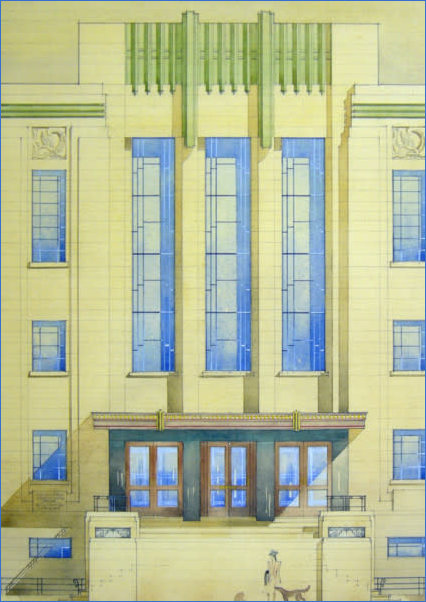
Appearing in 'Lost' the name of a new exhibition, curated by Ted Lightbown, which shows the changing face of Blackpool’s street scene. - Image sourced from the Blackpool Gazette
Among the many unique features of the baths was its roof, made from green Westmorland roofing slate, quarried in the Lake District at the time of the construction back in the 20s.
Two views of the entrance to the 'Lido'/Derby Baths showing the usual disregard of the original features over the two entrances but at least the beautiful frieze-like geometric designs at the top of the structure have not been damaged, vandalised or allowed to decay at this time.
A truly remarkable building has been lost - it may have been in the onset of decay but surely there should have been a Grade II listing granted - images sourced from Flickriver
South Shore Baths
The Blackpool Civic Trust also comments on the decline of this remarkable Wembley-like structure :
When opened in 1923, the Open Air Baths at South Shore were the largest in the world. The pool itself is attributed to the Borough Surveyor, Francis Wood, but J. C. Robinson designed the impressive faience-clad edifice around it. In 1935 new changing rooms were added. Records show high attendances before the war, but, by the 1980s, holidaymakers were becoming used to the waters of warmer climes, and the Baths had a reputation for cold water. They were demolished in 1983 for the Sandcastle water complex.
The Daily Mail includes a mention of the pageants and provides a memorable image :
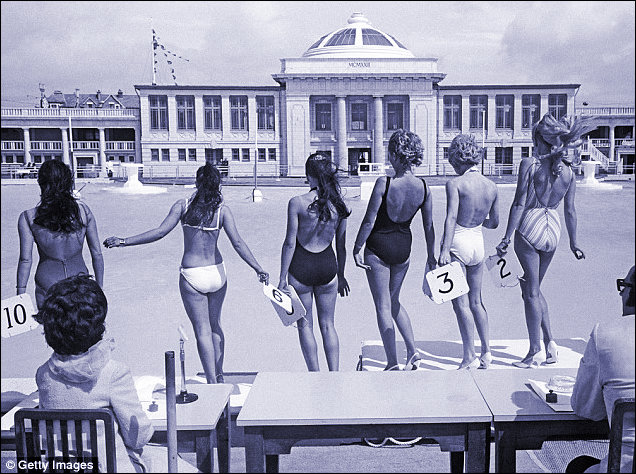
Flashback: The final of the 1970 Miss Blackpool Beauty competition, which was held at Blackpool Lido each summer - image © of Getty via the Daily Mail
The article entitled 'Take me to your Lido' reflect sadly : "Many of the finest lidos have been sadly erased from the landscape. Gone for ever, for example, is Blackpool’s Open Air Baths, which was once described as the ‘Wembley Stadium of swimming’ and a ‘Lancastrian temple to Neptune’. Archive pictures show a structure built on a vast scale, a place that hosted the finals of the Miss Blackpool beauty pageant no less." Of the surviving pictures, it is easy to see how it could have been described in the terms above!
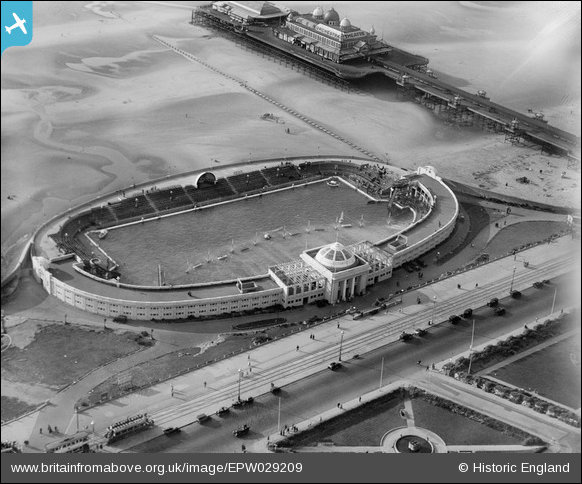
Taken in 1929 The Open Air Swimming Baths and Victoria Pier, Blackpool - image courtesy & © of britainfromabove.org.uk
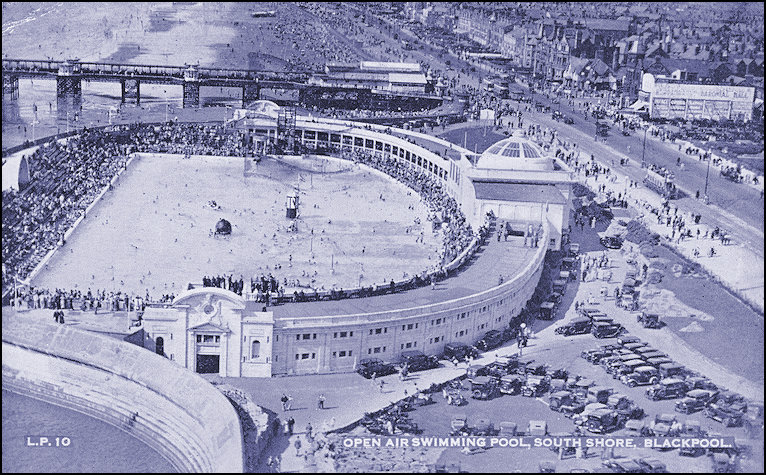
I'm not sure about the Temple to Neptune as I've no idea what that looked like - but I can certainly feel an affinity with the original Wembley Stadium!
What would I do without postcards for reference?
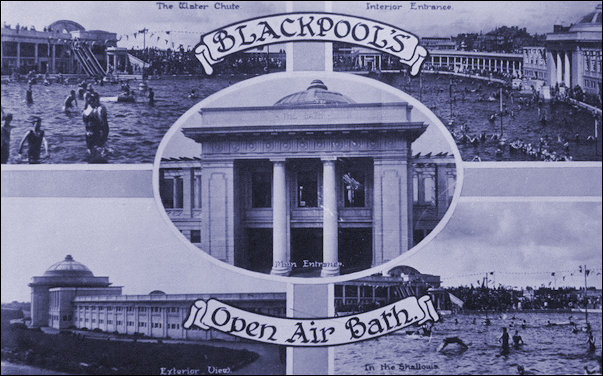
A rare multi-view of all aspects of the Open Air Bath - clockwise : The Water Chute, Interior Entrance, In the Shallows, Exterior view and the Main Entrance (centre).
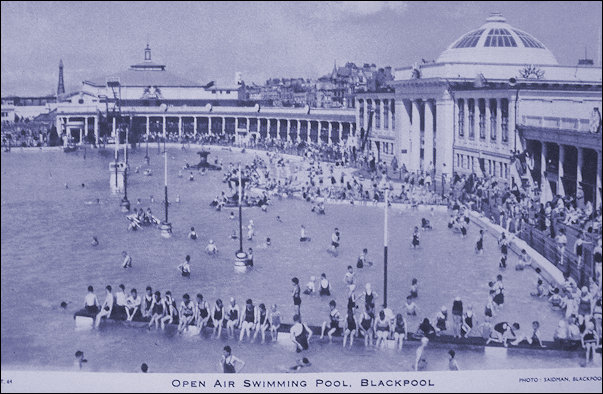
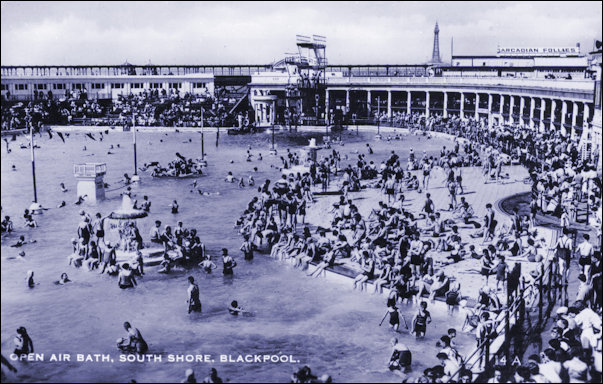
The number of people enjoying themselves gives an excellent perspective of the size of this open air venue in the two examples above.
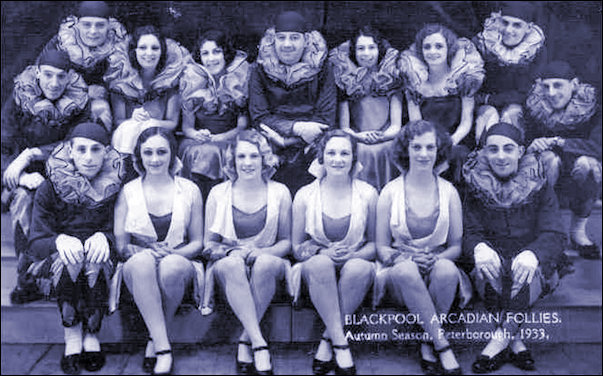
I was curious about the sign at the Open Air Swimming Pool announcing the 'Arcadian Follies' - I'm guessing they weren't an aquatic entertainment as found in the Super Swimming Stadium in Morecambe - but were certainly long lived. Here is the 1933 troupe sourced from the peterborough.images.co.uk blog
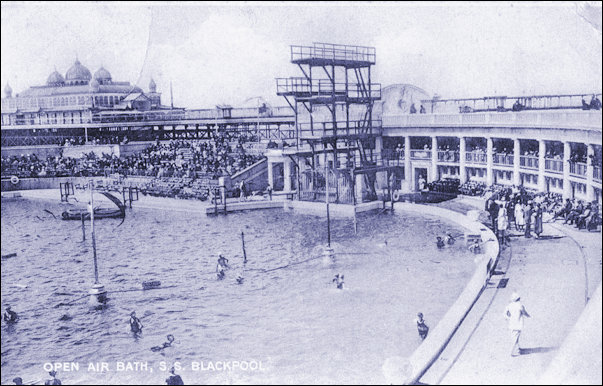
The 'Diving Towers' were a big attraction - I wonder when the term 'boards' instead of 'towers' came into being?
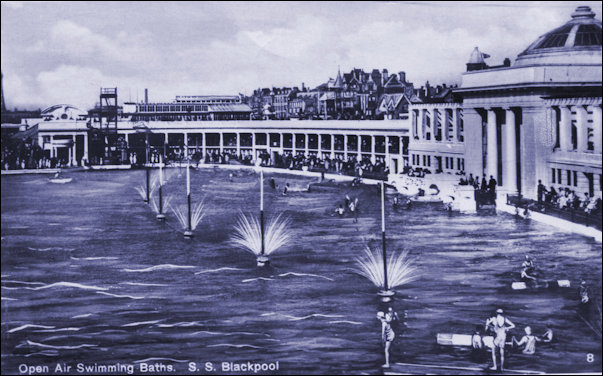
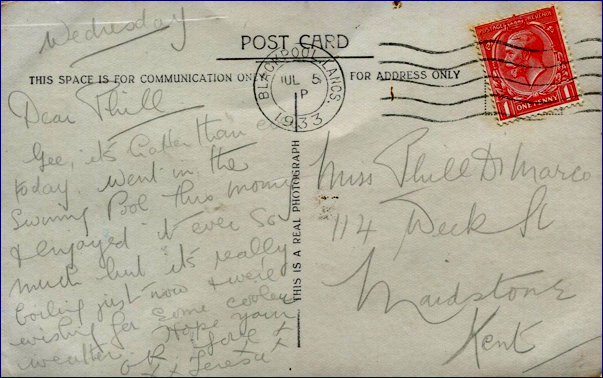
The two images above are the back and front of the postcard sent in 1933 before the addition of the changing rooms in 1935!
Ten Blackpool Sights that have gone forever
Two of them are the Derby Baths and read more here
At no. 2 - The open air baths opened in June 1923, modelled on the Colosseum of Rome. Over the years the baths provided a catwalk for thousands of bathing beauty queens. In the early 1930s it became a backdrop for the film Sing As We Go, whose star Gracie Fields signed the visitors’ book with the message: “Now’t wrong wi’ Blackpool Baths.” In 1959, another movie star, Hollywood’s Jayne Mansfield, visited the baths when she came to switch on Blackpool Illuminations.
A watch tower was built in the baths, for the safety of bathers – attendants posted on the tower had access to a small motor boat to aid them in the rescue of bathers in trouble. But eventually, it became a white elephant and was demolished in 1983, to make way for the all-weather Sandcastle.
At no. 8 - The Derby Baths opened in 1939, at a cost of £270,00 – 10 times more than any other pools of the era. Even in its early days, it was regarded by some as something of an expensive white elephant, but it did draw thousands in its role as water theatre. In its heyday, it could host more than 1,000 swimmers a day and had a capacity for 1,800 spectators. The building was a grand affair, with the heating and ventilation – which was blamed for condensation troubles in later years – costing £65,000 alone and the greatest expense.
But in the late 80s, the number of swimmers using the baths began to drop and the council made the decision it should close. Despite protests at the town hall by hundreds of people against the axe, the site was sold to Lonrho’s Metropole Hotels group in a £1.45m deal. It was demolished in 1990.
Page updated : 18th October 2019 (G)

